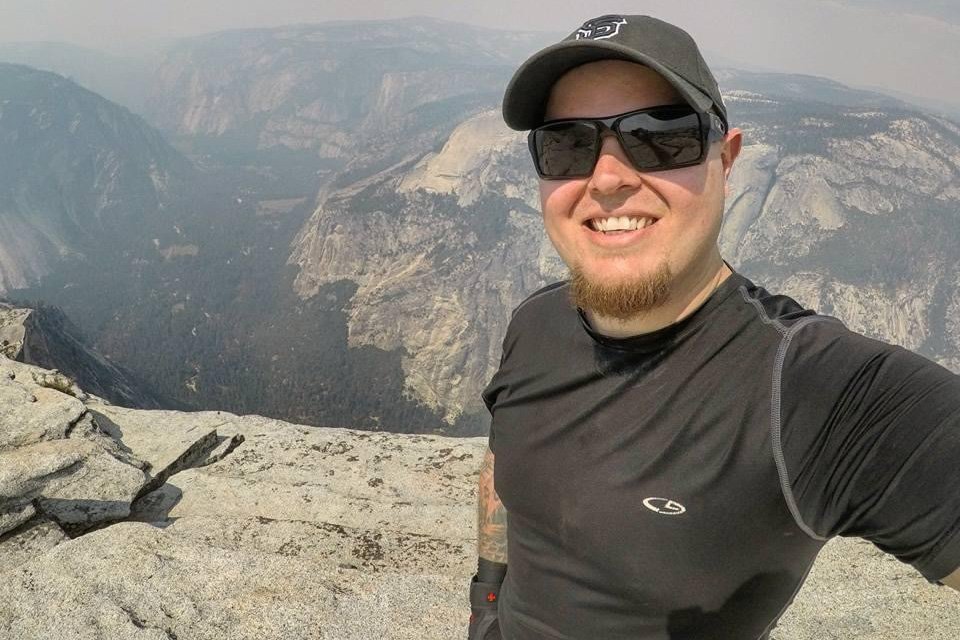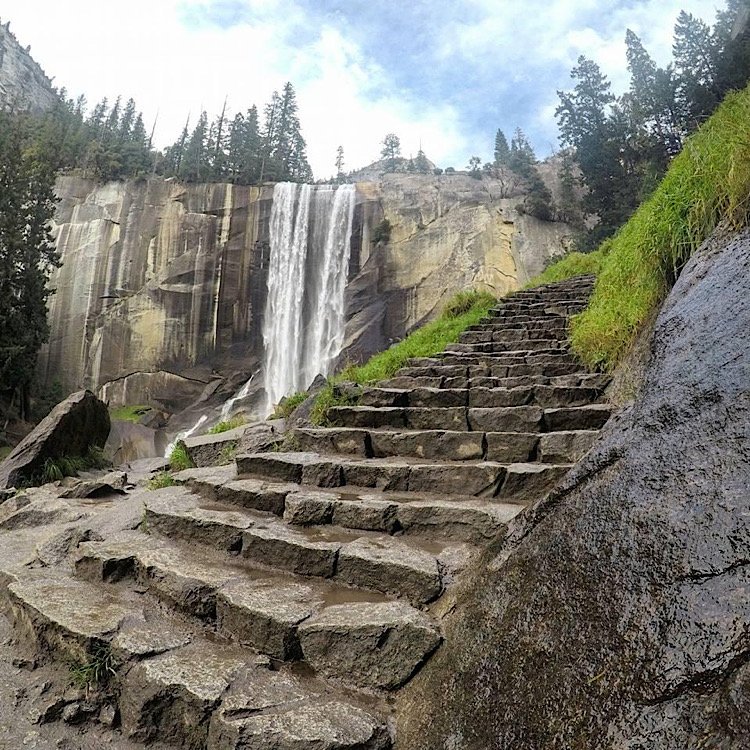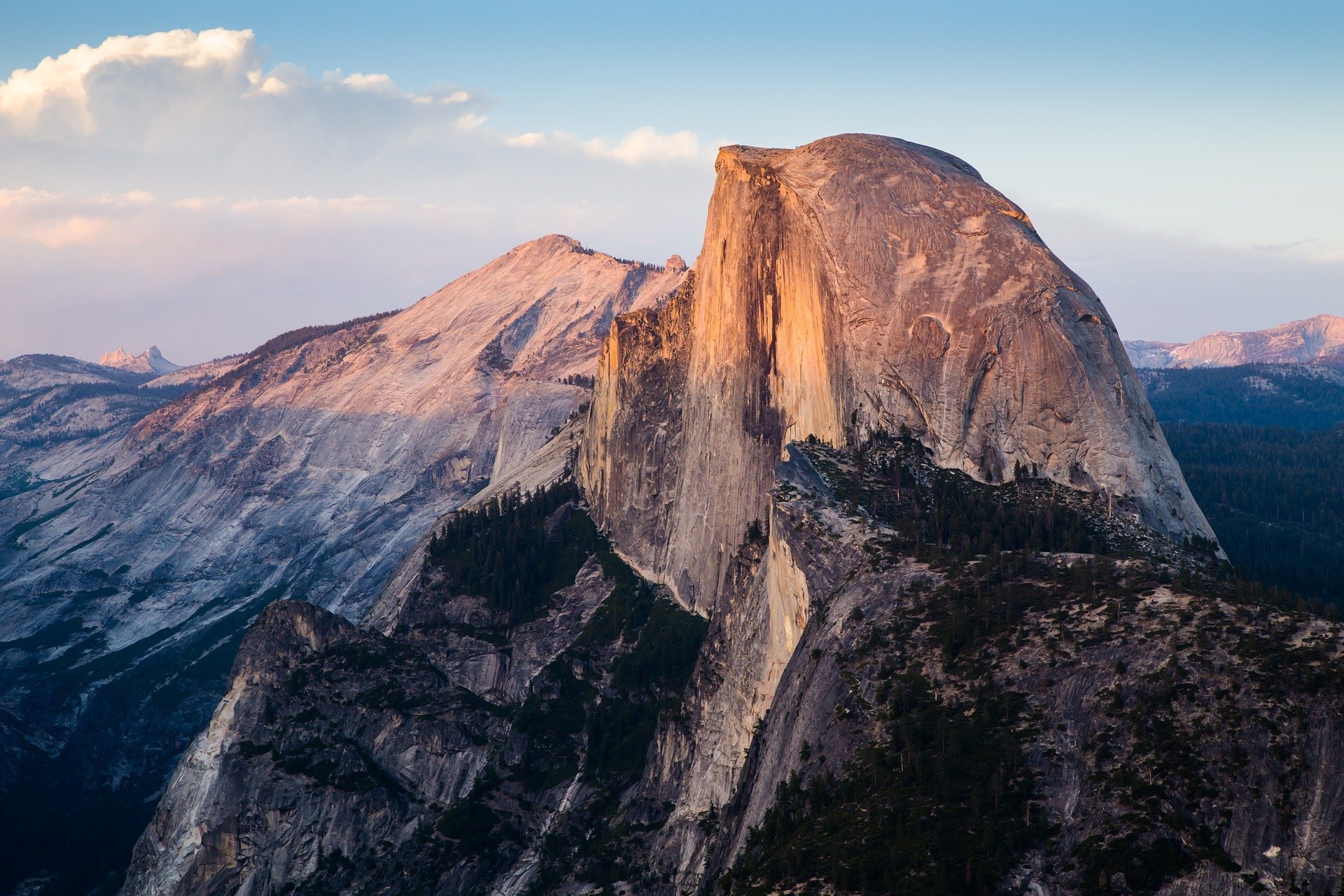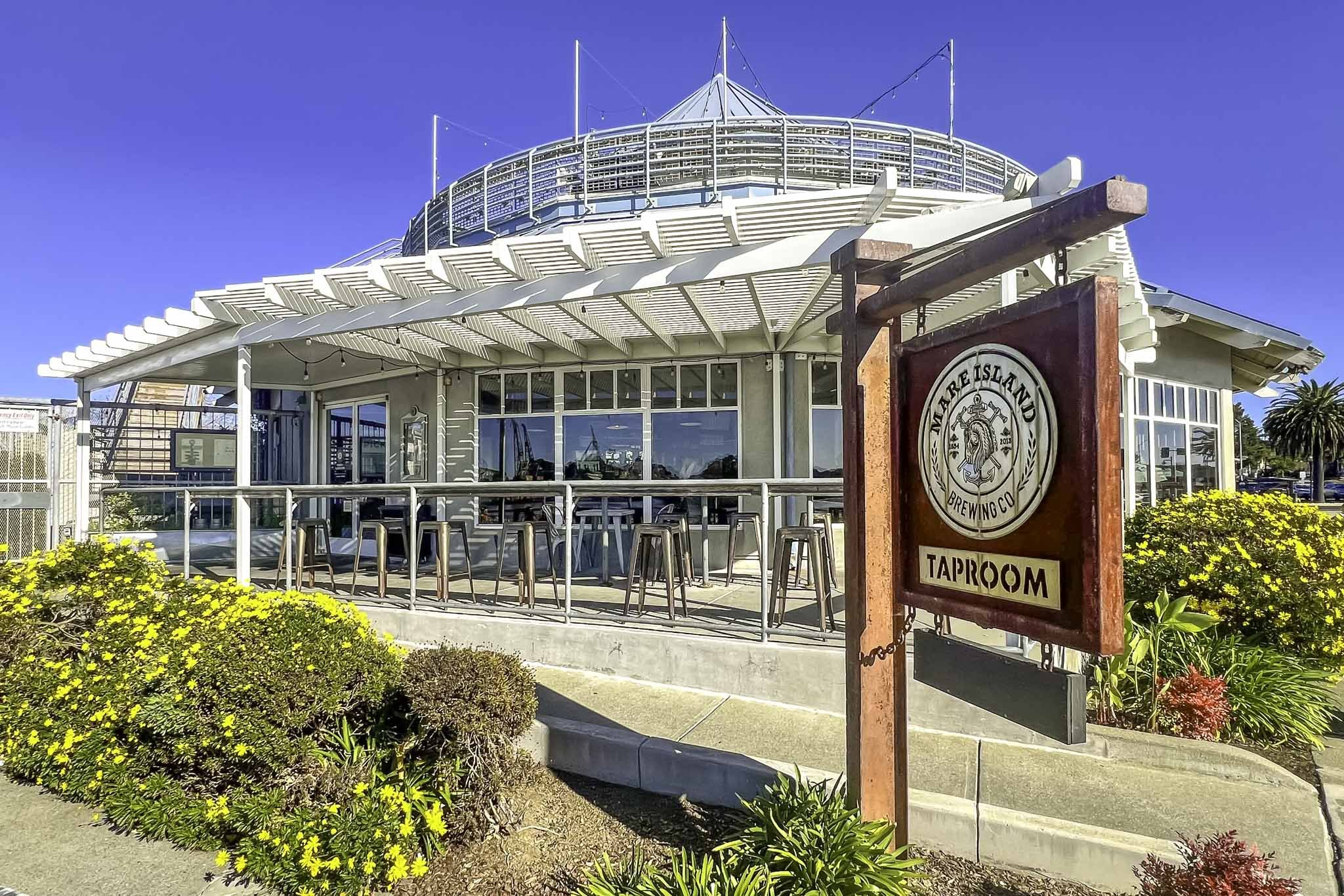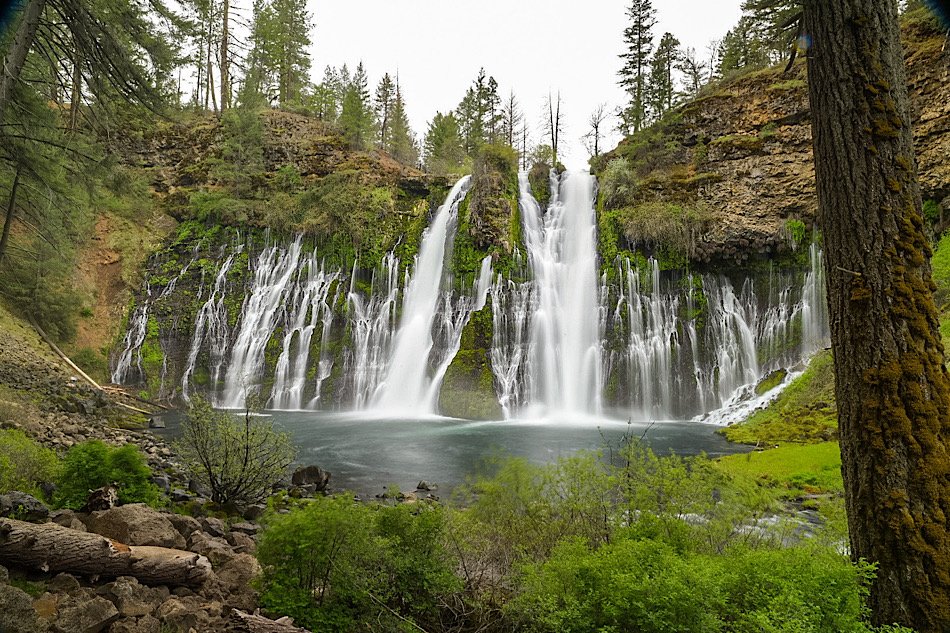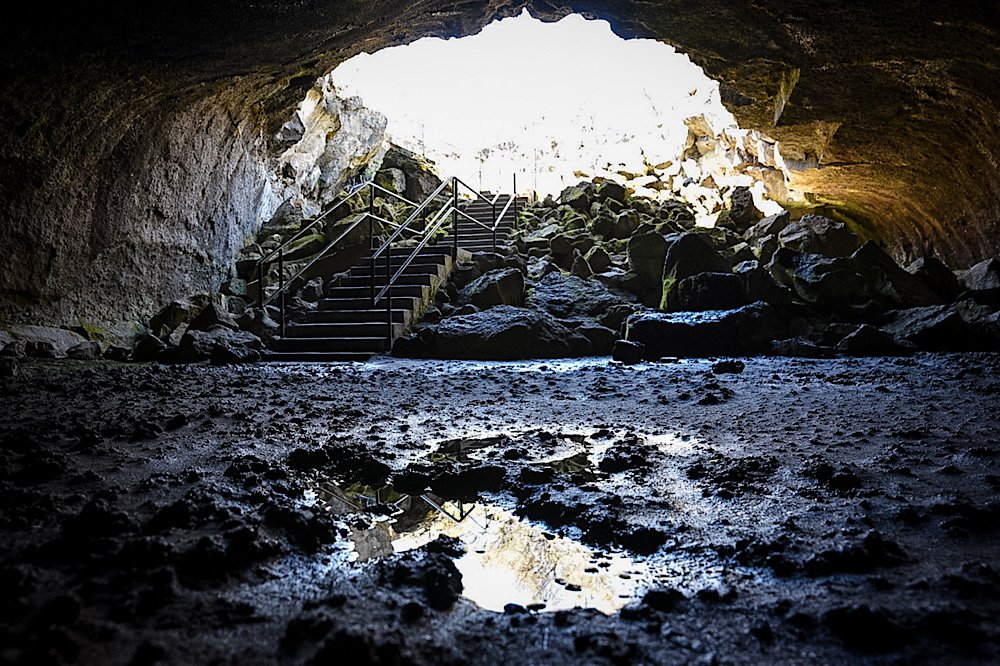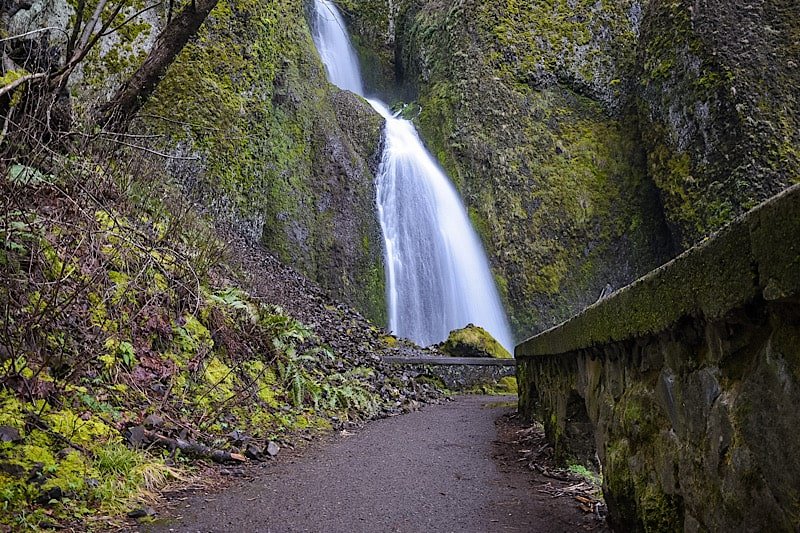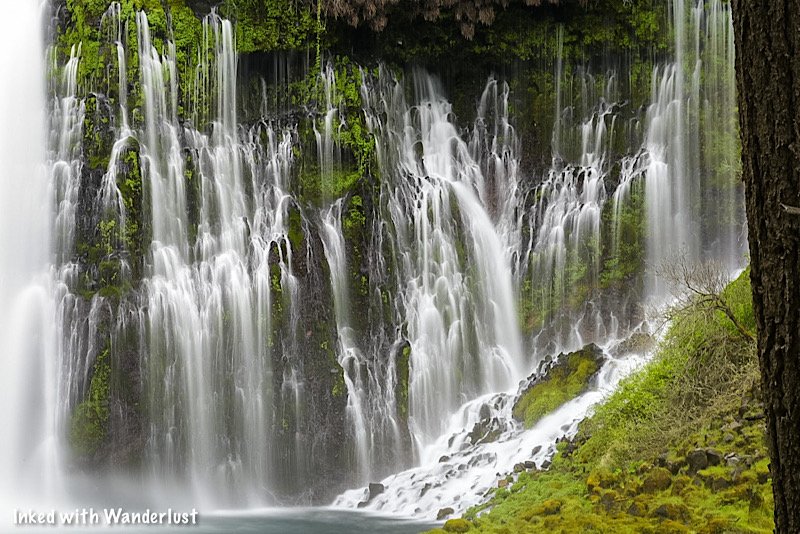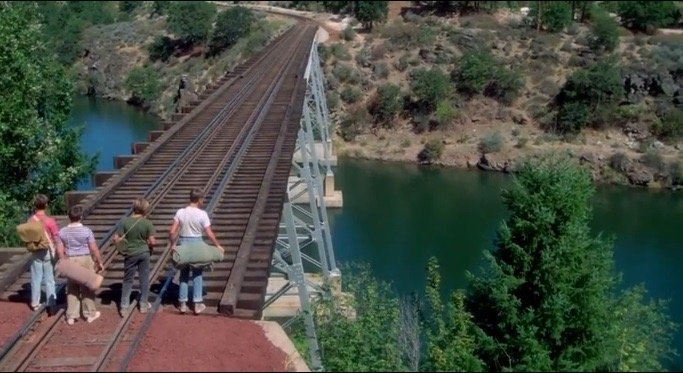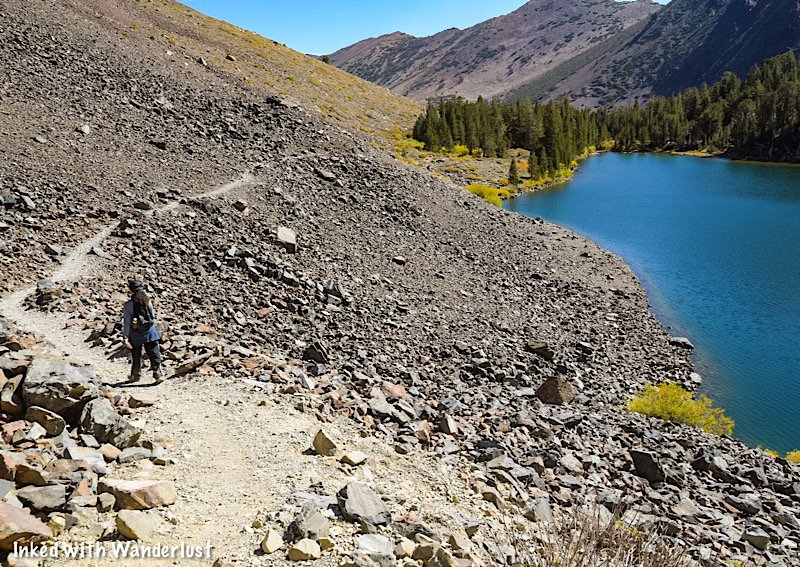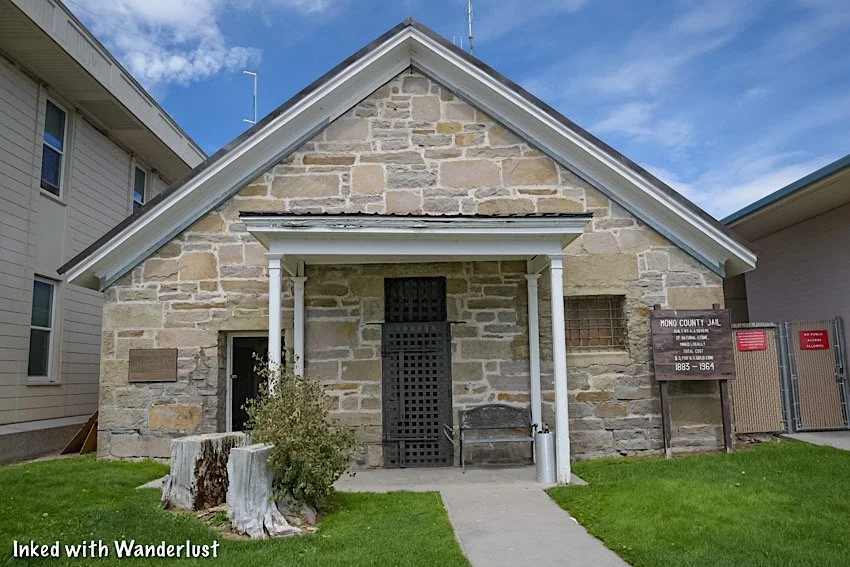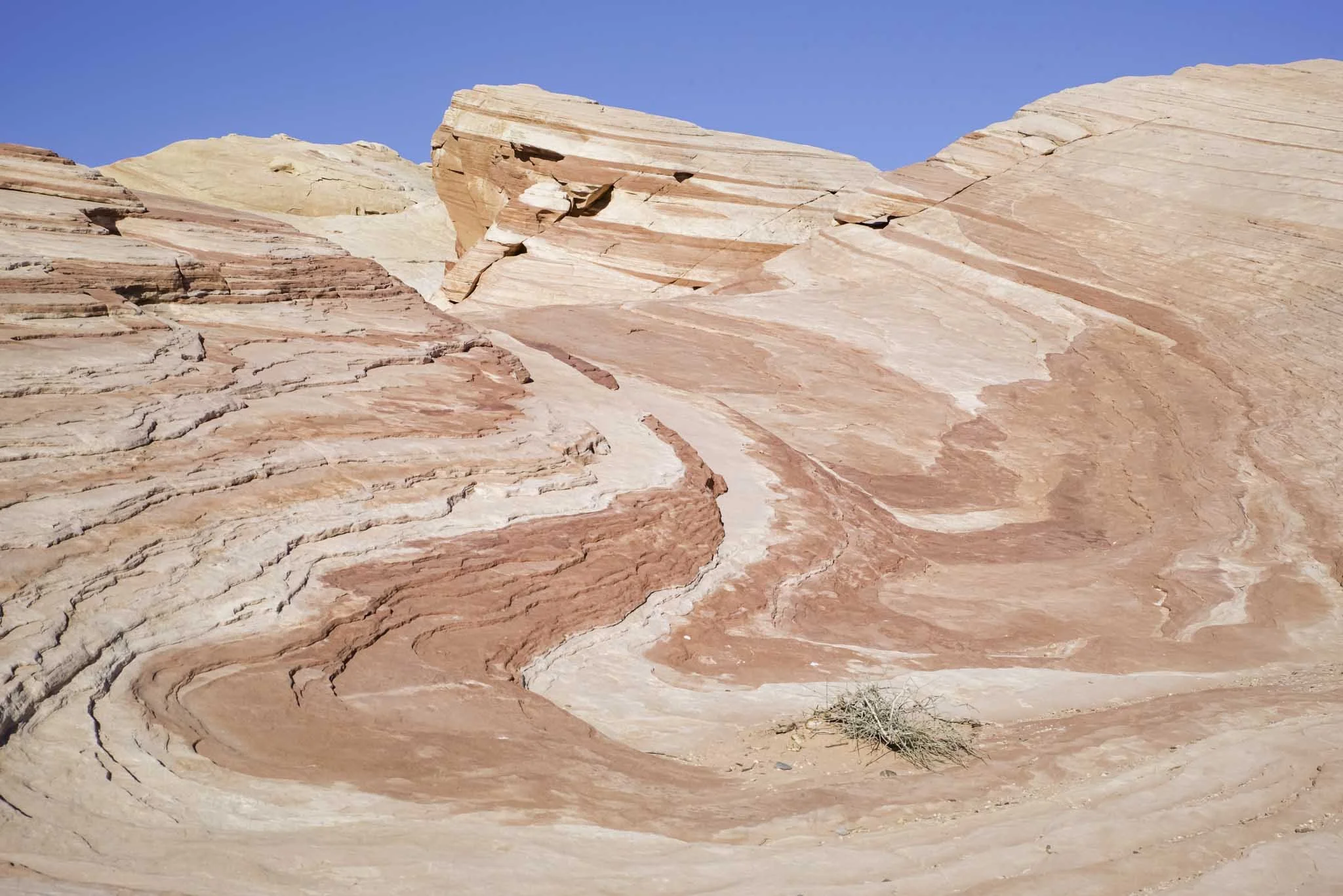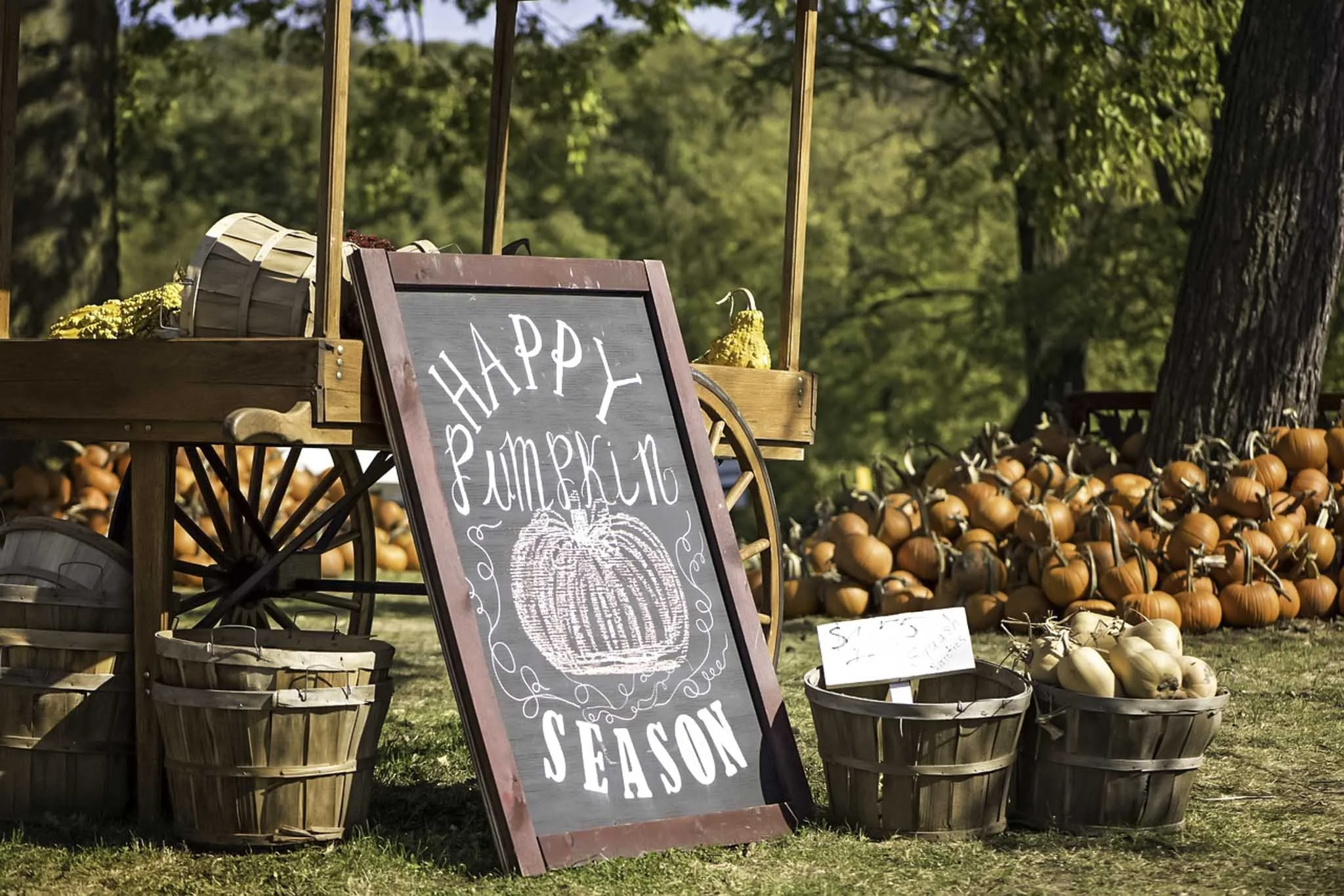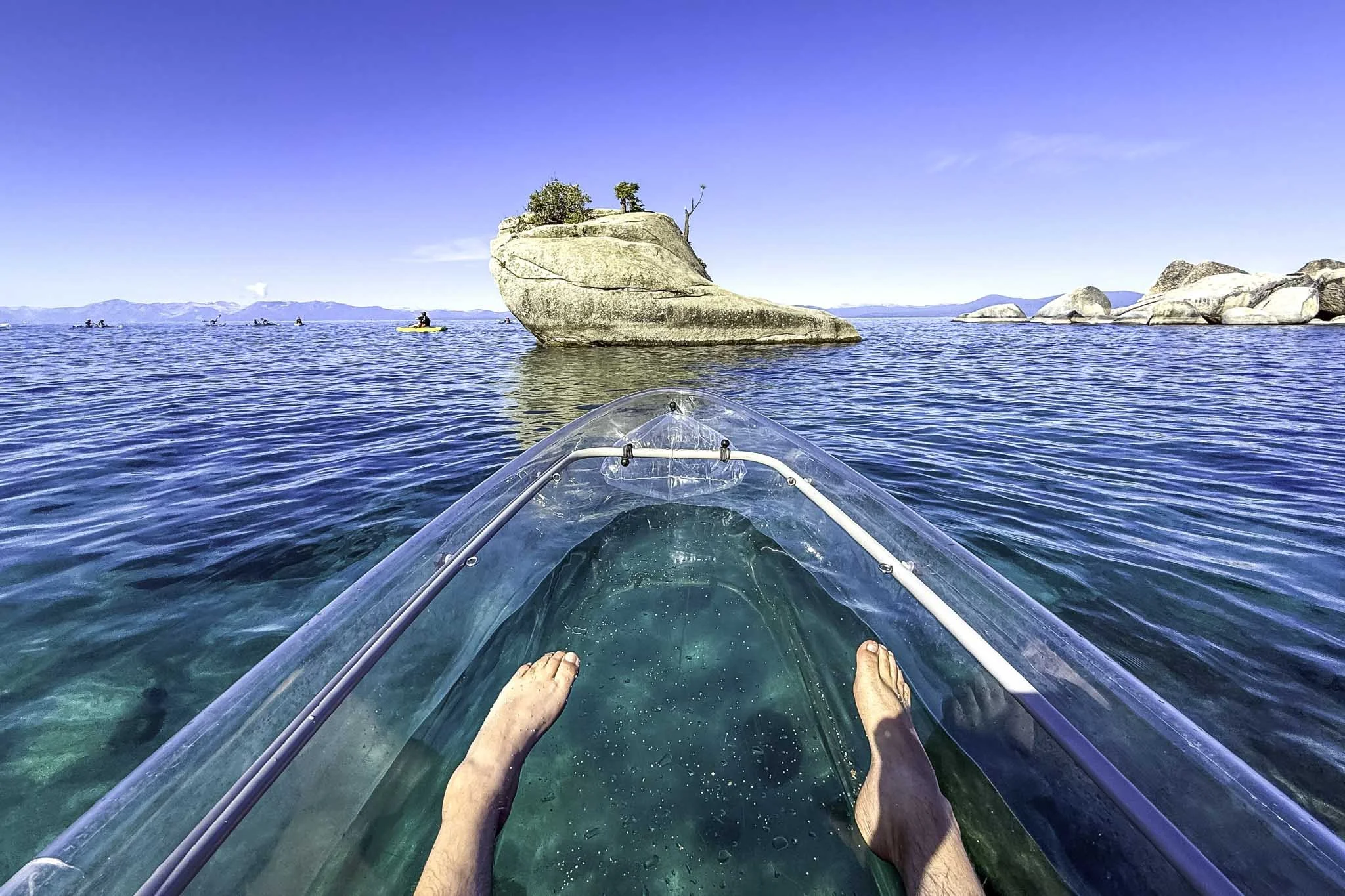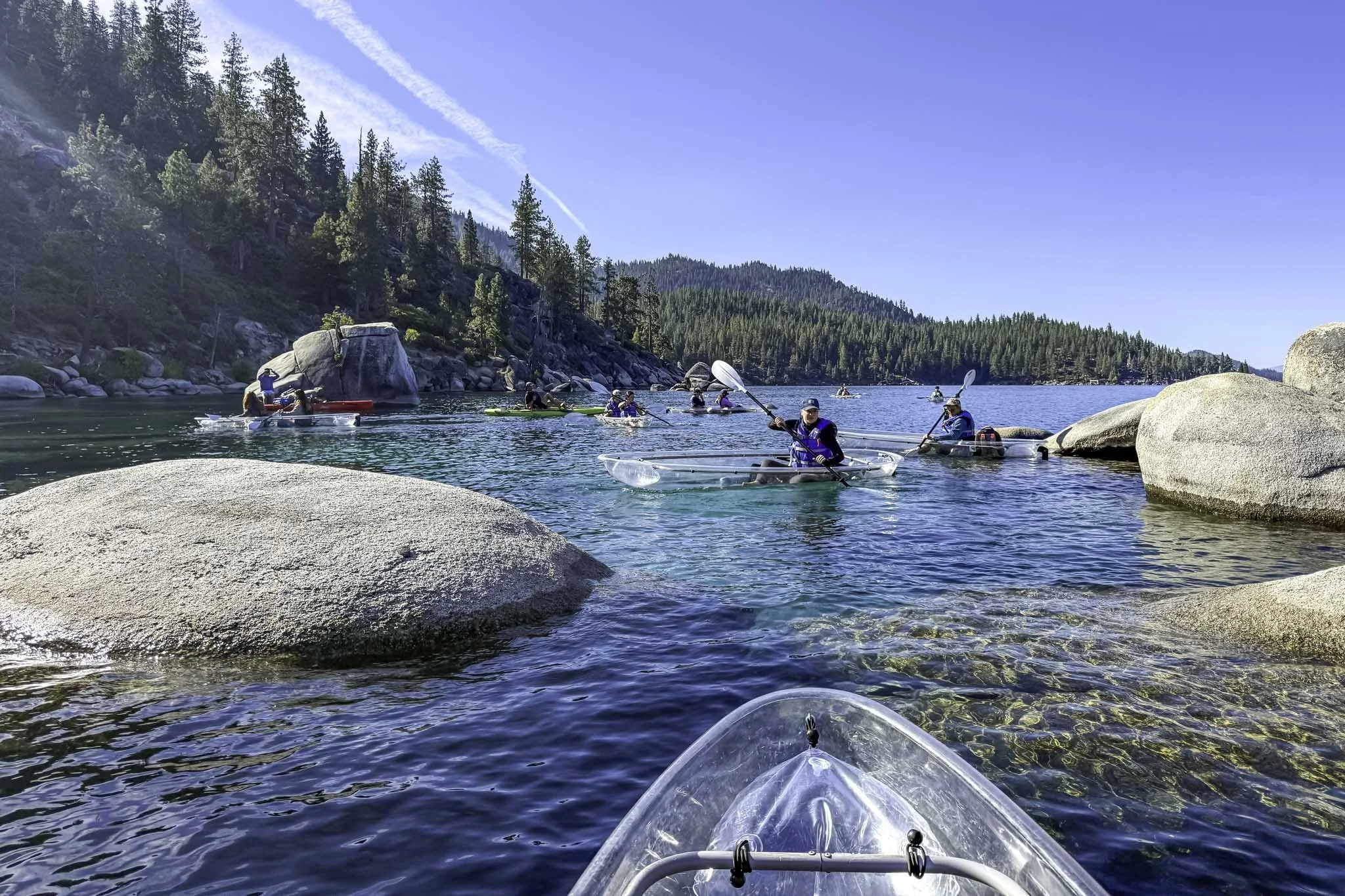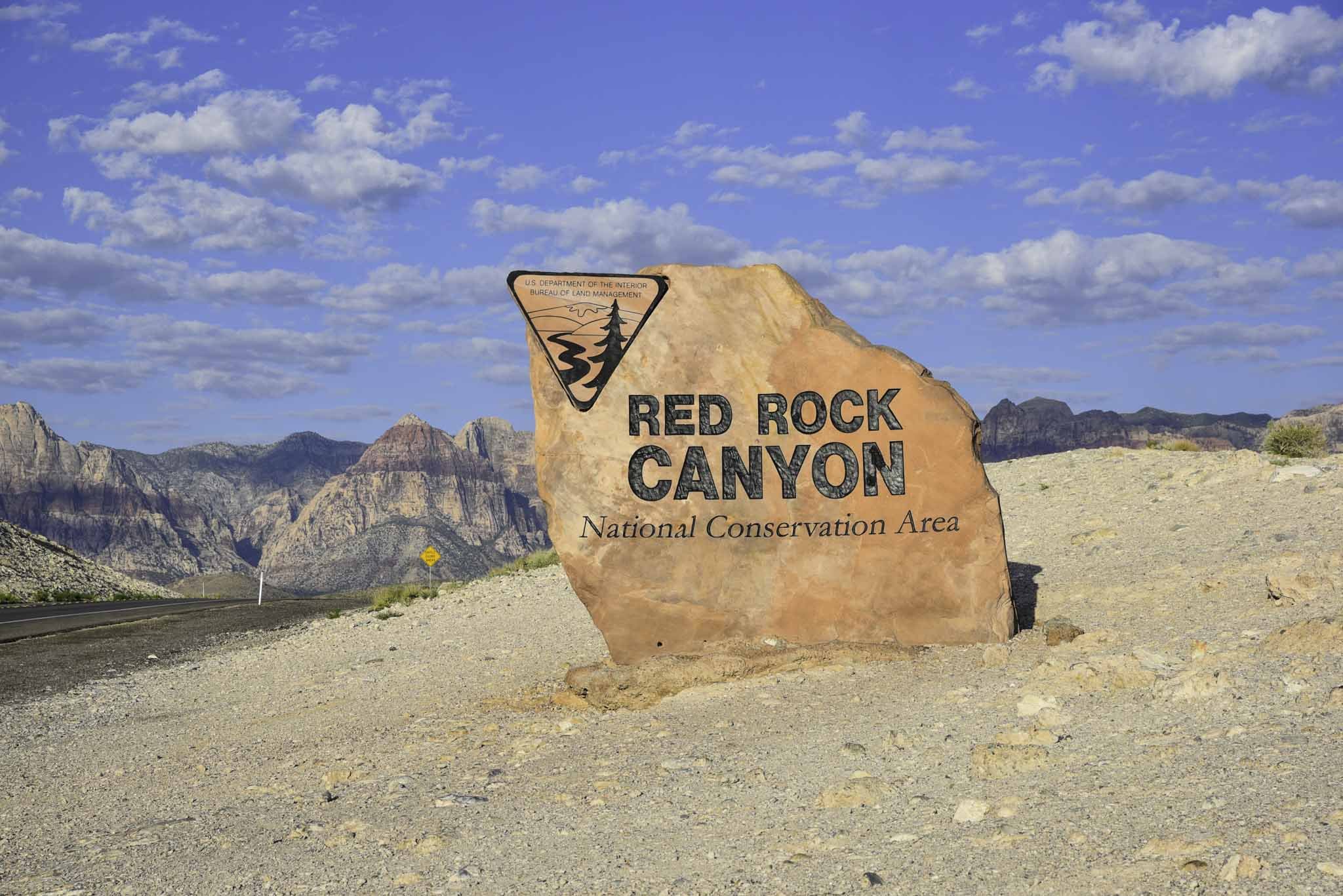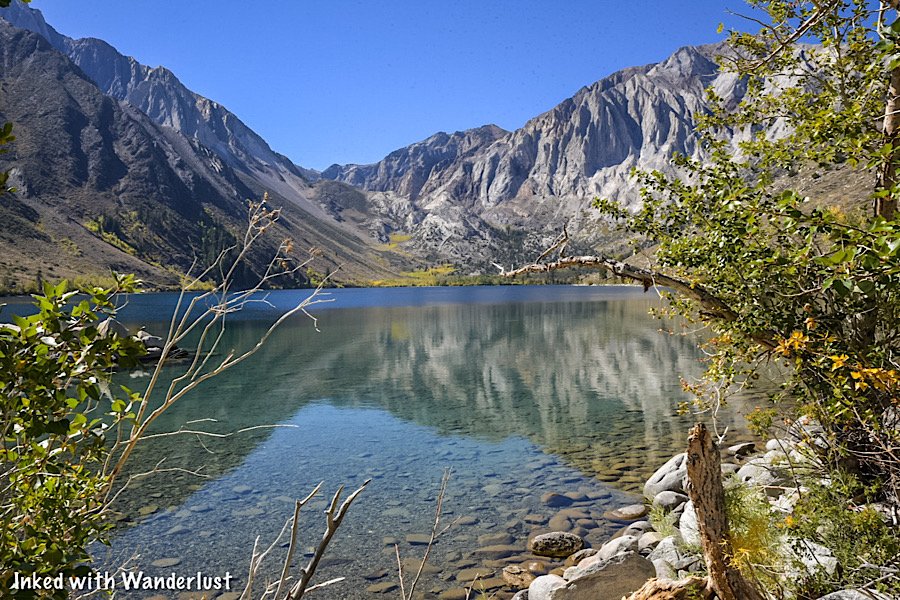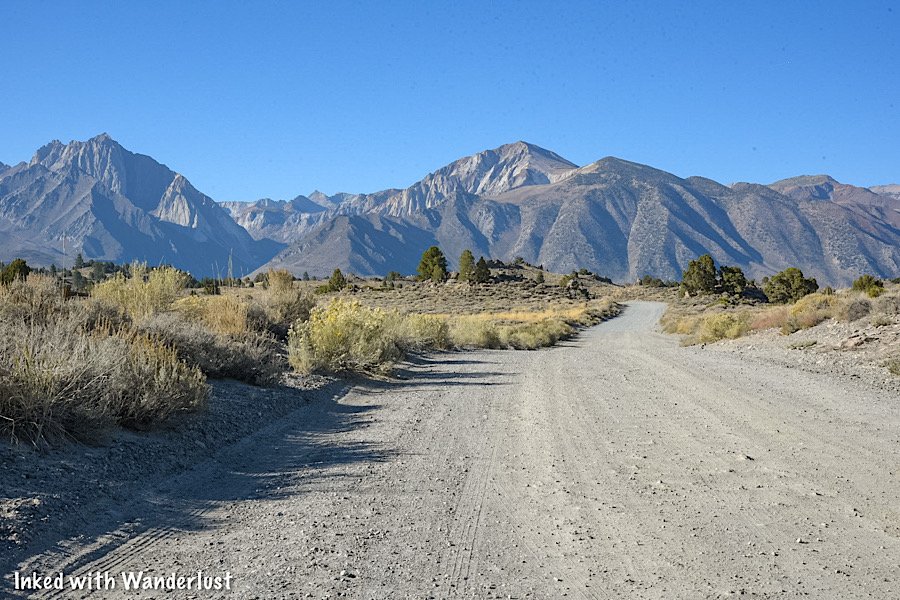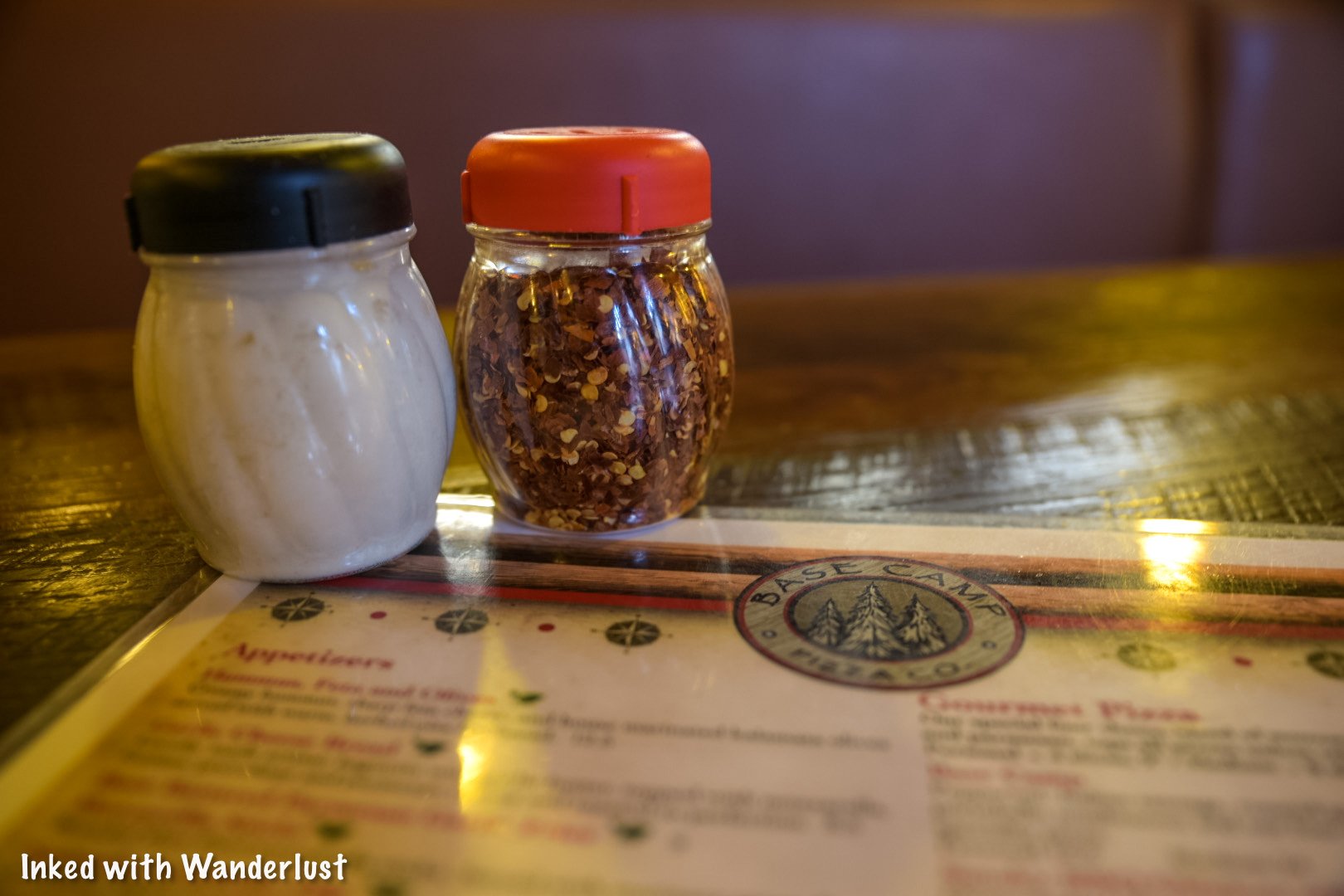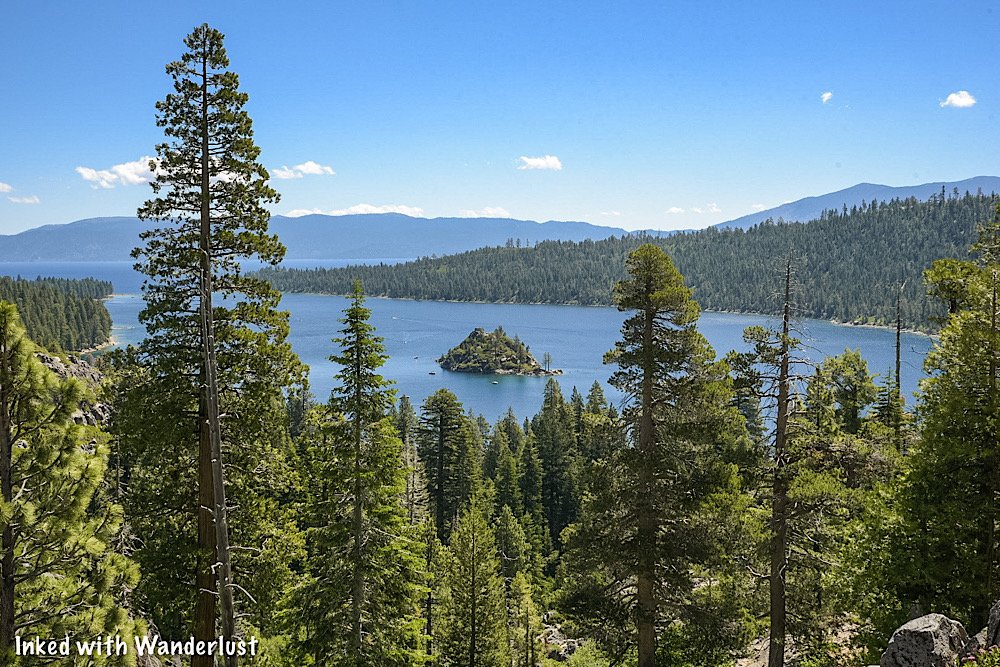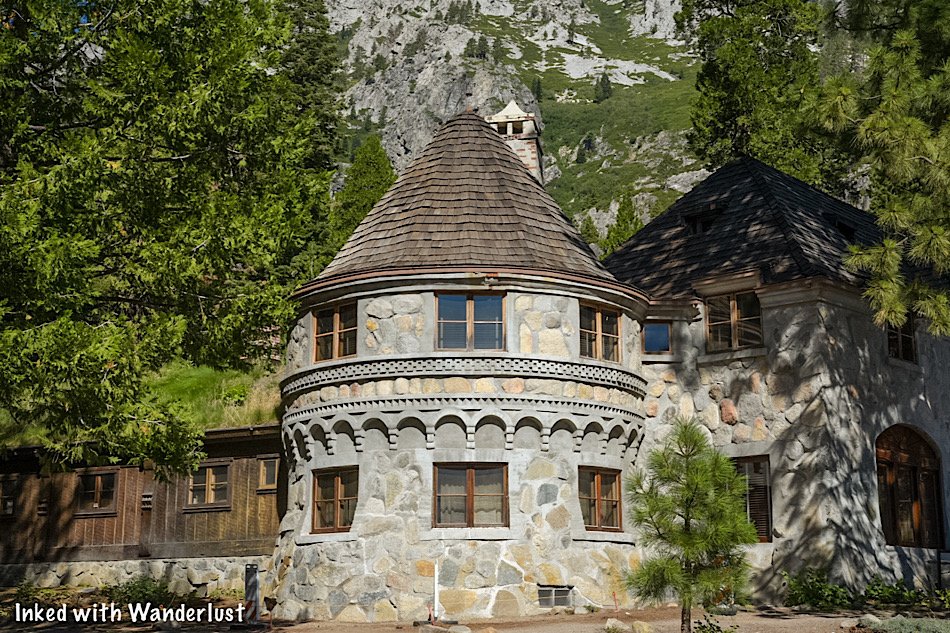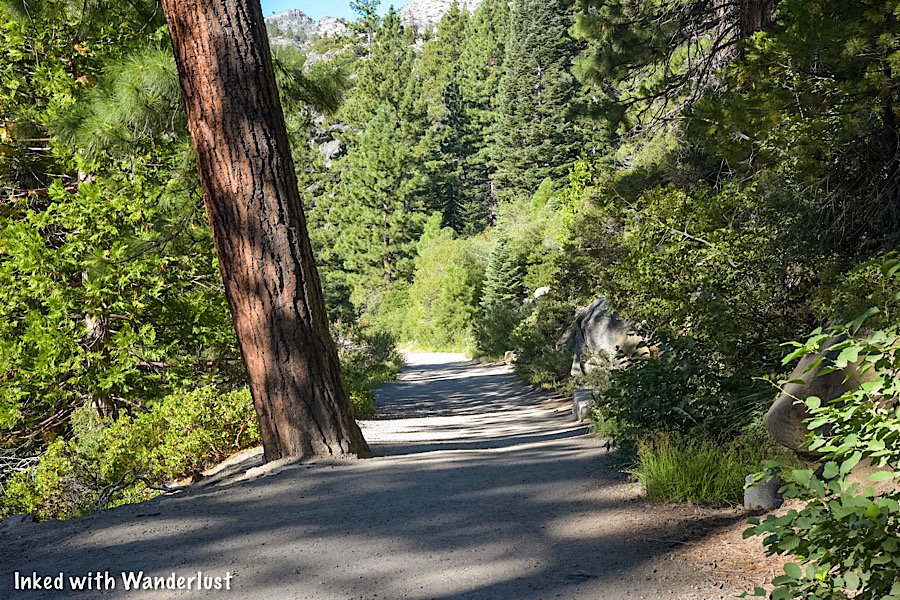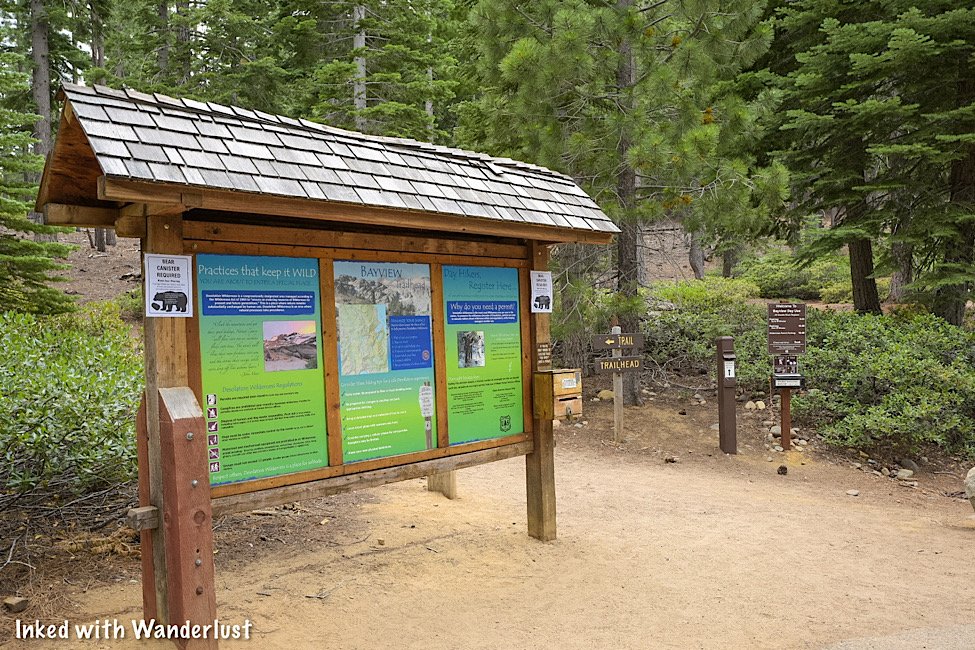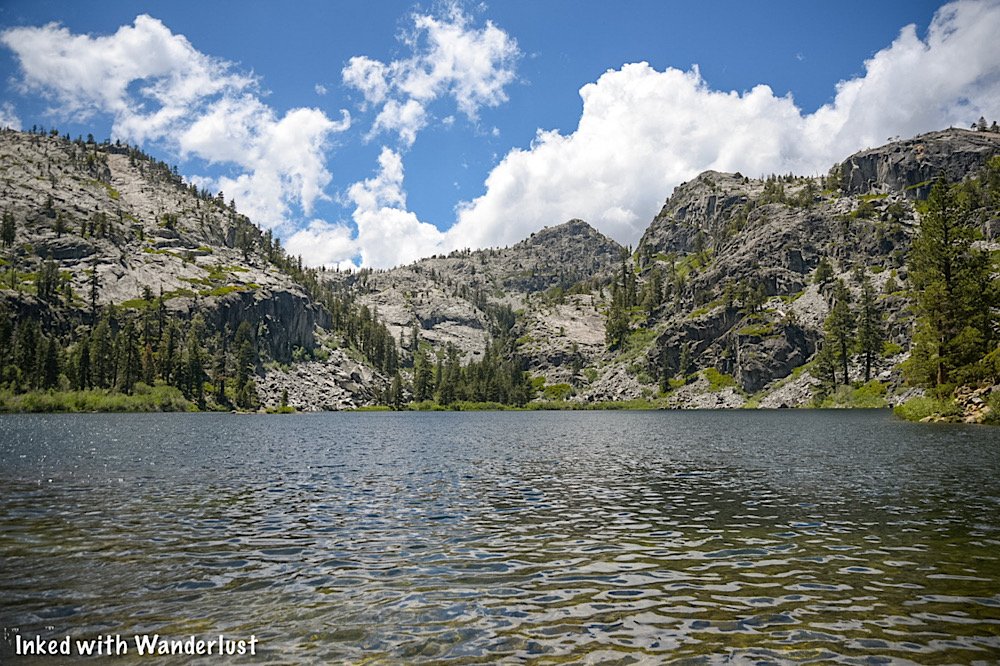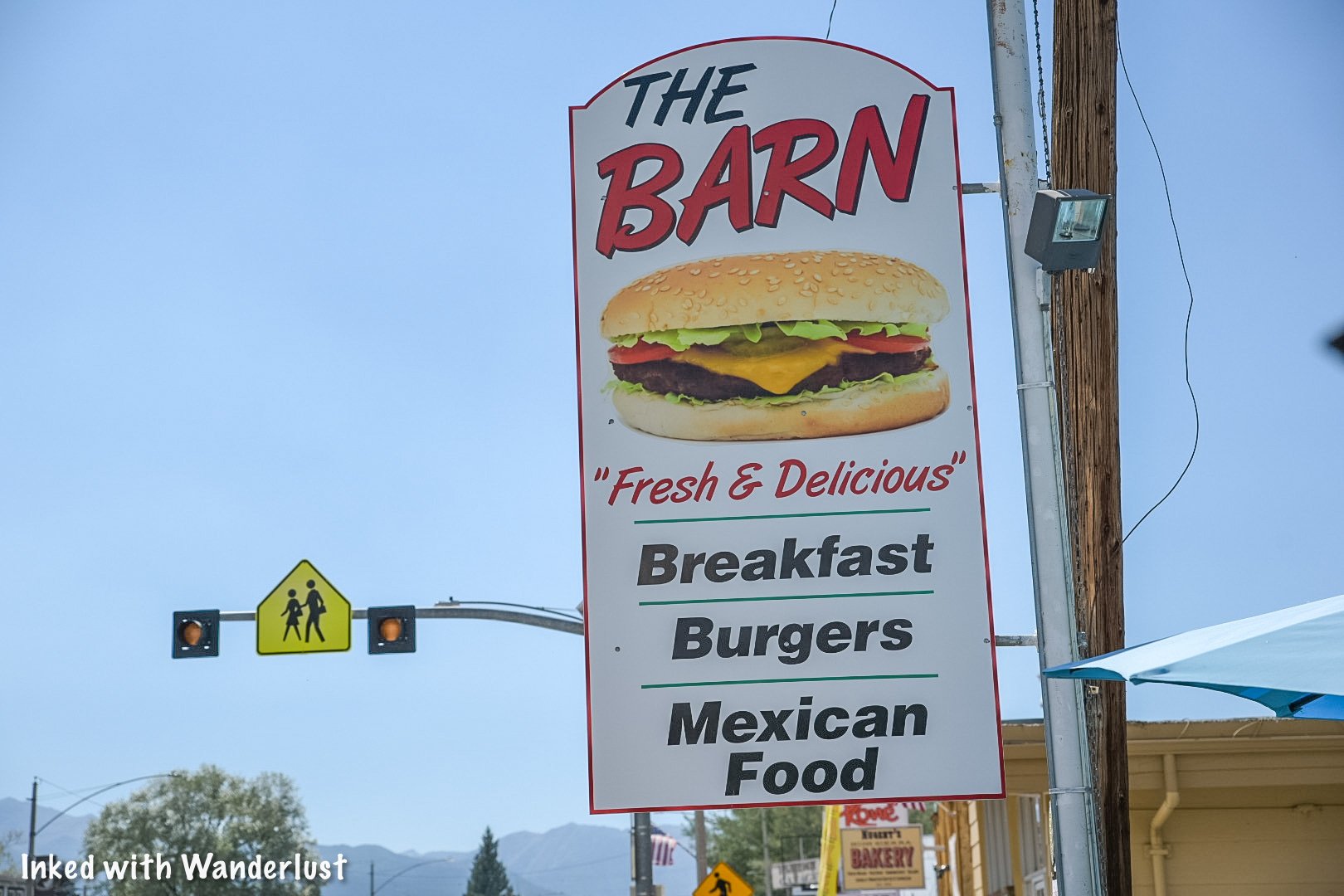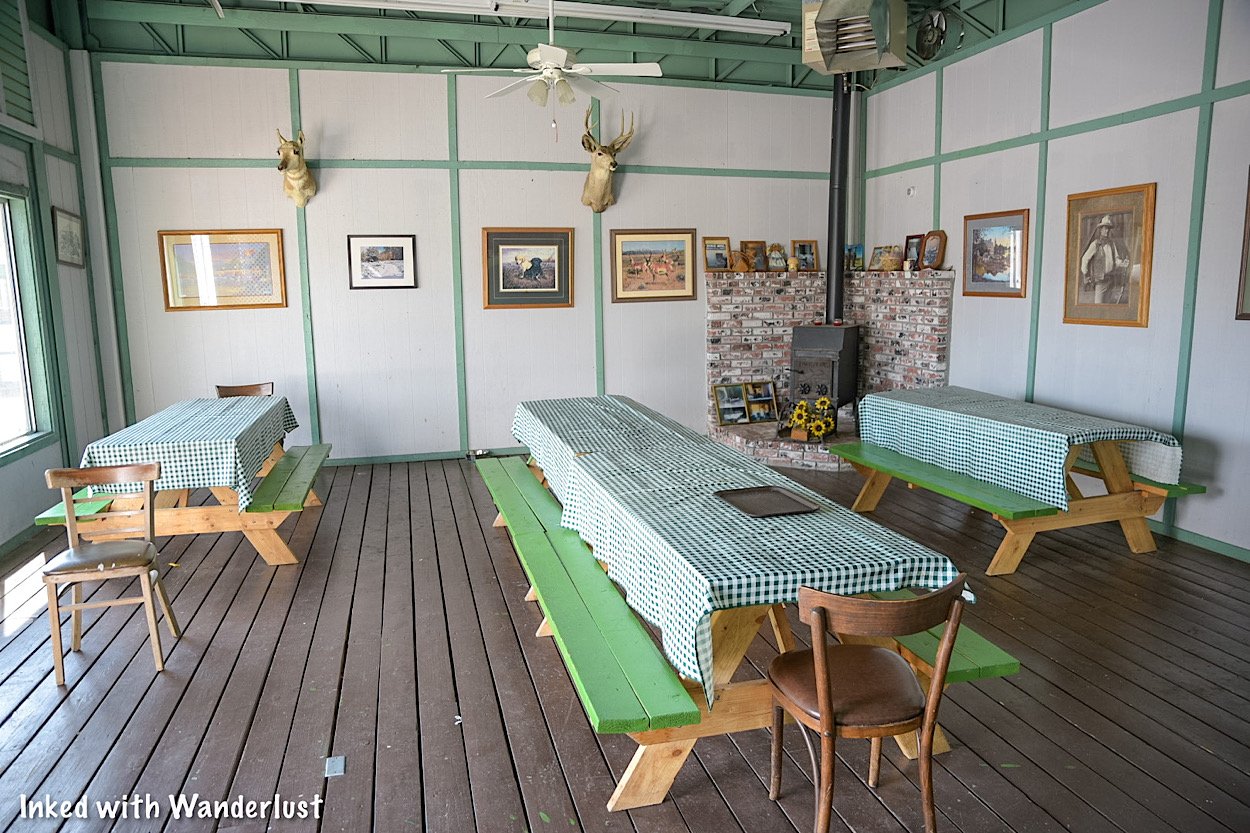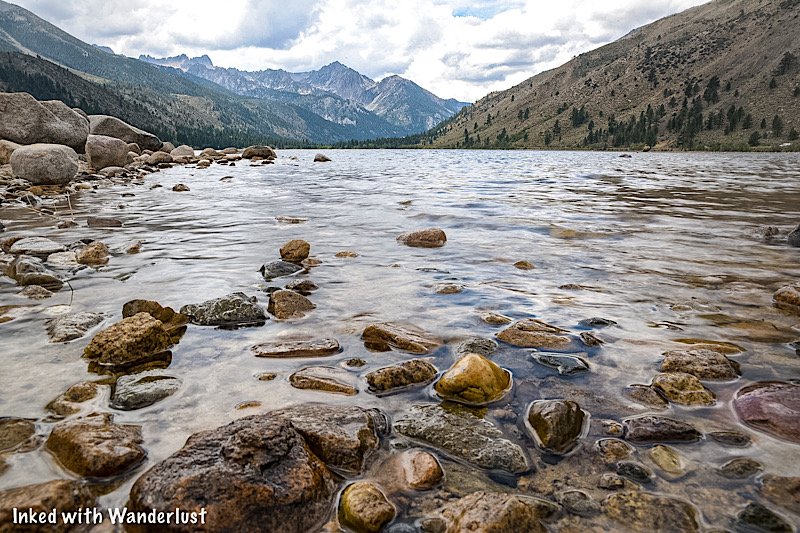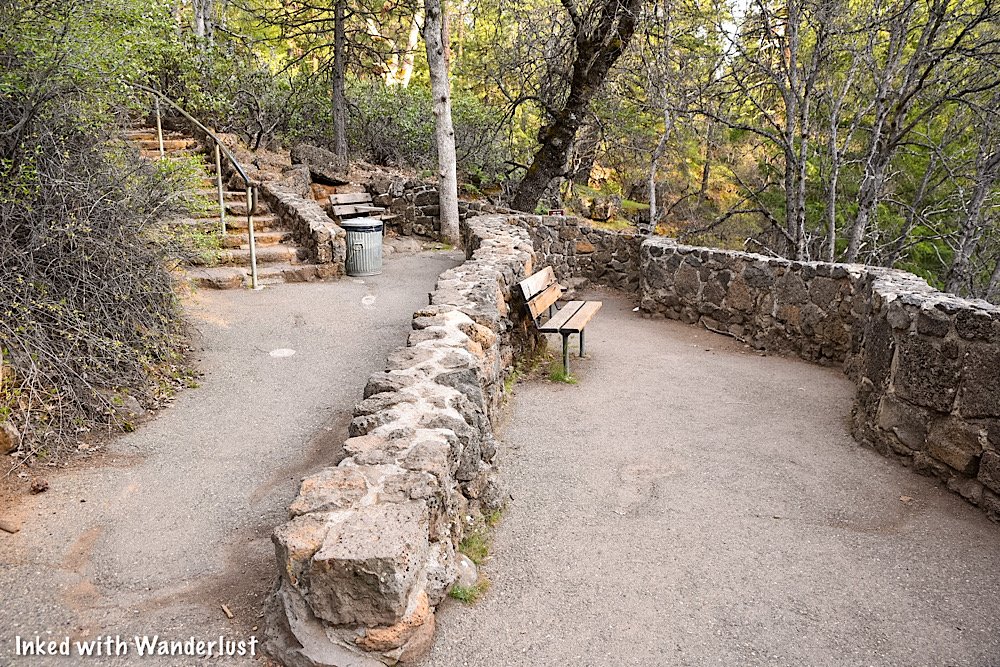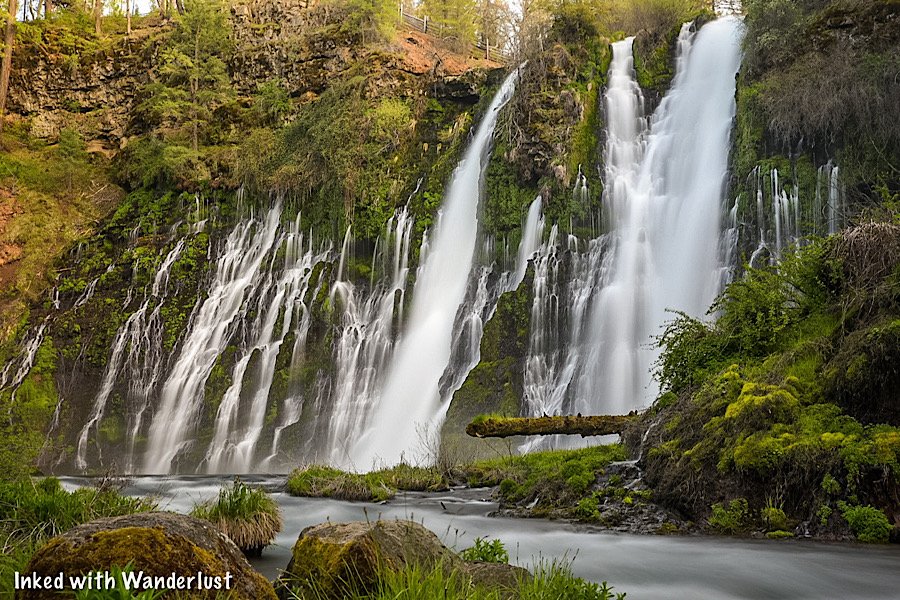Hiking Half Dome In Yosemite: My Journey In 30 Pictures
Back in 2020 when I launched this website, the very first published post was, “Half Dome: The Complete Guide To Yosemite’s Epic Day Hike”, and it’s…
3 minute read | contains affiliate links
In 2020, when I launched this website, the very first published post was, “Half Dome: The Complete Guide To Yosemite’s Epic Day Hike”, and it’s the one i’m most proud of.
The reason for that is because hiking Half Dome was a goal of mine and accomplishing that goal is what gave me the confidence and drive to launch Inked with Wanderlust.
The original post contains a ton of information and I highly recommend giving it a read if you’re planning to hike Half Dome (especially if it’s your first time).
*PRO TIP: Bookmark both of these posts to your device so you can return to the information later
This post, however, will be the shorter, stripped down version. It’ll focus solely on the trail itself and nothing else. So you’ll quickly get an idea of what this hike is like.
It’ll also focus solely on the trailhead where most Half Dome hikers begin their journey; the Happy Isles trailhead and through the Mist Trail.
If reading this post gives you some inspiration to hike Half Dome yourself, check out our ultimate beginners guide here (opens a new window).
Quick Stats
Location: Yosemite Valley, California
Fee: $35 to enter Yosemite + applicable permit fees
Permit: Required when cables are up (typically between Memorial Day and Columbus Day)
Open: All year (cables are down during winter)
For: Hikers
Restroom: Five: 1) At the trailhead 2) At the Vernal Fall footbridge 3) Near the Emerald Pools at the top of Vernal 4) At the top of Nevada Fall 5) At Little Yosemite Valley campground
Parking: Large dirt lot a quarter-mile from the trailhead
EV Stations: None
Difficulty: Hard
Popularity: Extremely high
Mileage: 14.2 - 16.5 miles, RT (depending on which route you take back)
Time: Full day/Overnight
Elevation Gain: 4,800 feet
Condition: Maintained and easy to follow
Features: Two waterfalls and summiting Half Dome itself
Pets: Not allowed
Drones: Not allowed
Hazards: The slick stone steps of the Mist Trail and the potential for fatal falls
Our Visit(s): 2017
Half Dome Trailhead and Parking
For most hikers, the official starting point for Half Dome is the Happy Isles trailhead. Which is also the trailhead for the Mist Trail and John Muir Trail.
There is no parking lot at Happy Isles itself. The nearest one is a large dirt lot located about a quarter-mile down the road (near Curry Village).
To get to it, look out for Curry Village signage and follow them. As you near Curry Village, you’ll see signage pointing the way to the parking lot.
The lot is known to fill quickly. Especially during the summer and spring season. Plan for an early start, pre-dawn preferably. I began my hike at 3am.
If full, you can always utilize the shuttle. It’ll drop you off near the trailhead. Keep in mind, though, that the shuttle doesn’t begin operations until 7:00am.
The Mist Trail
Aside from Half Dome, the Mist Trail is arguably the most popular trail in Yosemite. It features two beautiful waterfalls (Vernal and Nevada Falls) in a relatively short hike.
If you’re here in spring or early summer, prepare to get wet. They don’t call it the Mist Trail for nothing. Later in the season, it isn’t so dramatic as run-off is minimal.
One danger you’ll need to be cognitive of are the stone steps. There are hundreds of them and they get incredibly slick from the constant mist.
From the trailhead, it’s 1.5-miles to Vernal Fall. By the time you’ve reached Nevada Fall, you’re about 3.5-miles in.
Between Vernal Fall and Nevada Fall you’ll get a reprieve from the stone steps as the trail turns to a traditional dirt path.
After crossing the footbridge near Nevada Fall, the stone steps return as you work your way to the top of the beautiful waterfall.
At the top of Nevada Fall is a restroom and a few benches/rocks scattered about to sit on. It makes a great spot to relax and gather yourself.
Little Yosemite Valley & Incline
After Nevada Fall, you’ll start on the one and only flat portion of the trail. Be sure to enjoy the reprieve because it won’t last long.
This stretch will take you through what’s known as Little Yosemite Valley (where a backcountry campground by the same name is located).
When you reach the campground, you’re right around the halfway mark to Half Dome. There, you’ll find your fifth and final opportunity to use a restroom.
Shortly after the campground is when you’ll again begin another relentless incline as you make your way to Sub-Dome.
You’ll make your way up the mountain via a series of switchbacks. They’re not difficult but if you’re not used to the elevation, you’ll feel it.
Sub-Dome
Sub-Dome is your final obstacle before reaching the cables. I believe Mother Nature designed it to do one thing; destroy whatever’s left of your legs.
It’s a mini granite-dome connected to the back half of Half Dome. A series of short switchbacks built into the granite take you to the top.
This is also the point in the hike where you’ll likely need to show your permit to a Ranger for inspection (if there’s one stationed there).
Sometimes the Ranger is stationed just before Sub-Dome, sometimes their stationed at the top. Don’t risk going through all that if you don’t have one.
READ ALSO: “Half Dome Permit: The Ultimate Permit Lottery Guide”
Half Dome Cables
From here, the only thing standing between you and the summit are the cables. The cables are there to assist you in reaching the top.
They’re placed in the granite and feature a wooden plank between two steel poles every six feet or so. Along the entire length are two elevated steel cables.
To use them, simply grab hold of the cable and hoist yourself upward to each wooden plank. My brother and I used those planks as resting points.
The space between the cables isn’t very wide and those going in both directions share the space. No matter your direction, stay to the right.
If you want to use a harness to secure yourself, you can. You’ll need to unhook/hook-up again at every pole so it will slow you down a bit.
If you feel like you need to take it slow, that’s perfectly fine. Just keep in mind that people behind you may want to go faster. If so, simply let them pass.
When I was on the cables, I was impressed by how cooperative and helpful everyone was to each other. There was no chaos or rudeness.
To me, the ascent wasn’t that bad. It looked much worse in pictures and video. Still, it gets near vertical the higher you go, so take precaution.
Half Dome Summit
Reaching the summit of Half Dome is quite the accomplishment for all who attempt it. For me, this was an “Everest” moment (cheesy, I know).
The views are astounding no matter which way you look. Walk straight (away from the cables) to the edge to get a commanding view of the valley.
Other points of interest visible from Half Dome are North Dome, Cloud’s Rest, Glacier Point, Tenaya Canyon and more. The views are simply unsurpassed.
The summit is about the size of seven combined football fields, so there’s plenty room to walk about and explore. So take your time.
One thing I should mention - if you see dark clouds coming, head back down asap. You do not want to be stuck up there during a storm.
Heading Back
When you’re finished, simply head back the same way you came…with one exception. When you reach the top of Nevada Fall again, you’ll have two choices:
Head back down the Mist Trail (remember the slick, stone steps)
Take a detour down the John Muir Trail (JMT)
When I hiked it, we made the decision to hike back down the Mist Trail because on our way up, it was still dark and we didn't see much.
Trust me when I say that if there’s one aspect of our experience I regret, it’s not taking the JMT detour. My legs were jello and navigating those steps was miserable.
Taking the detour will add another mile or so to your hike BUT…you won’t have to contend with the steps. It’s a standard dirt path.
Your Thoughts…
I’d like to know your thoughts on hiking Half Dome and the cables themselves. Is this something you think you’d want to do?
Have you done it? If so, i’d like to hear your perspective. Perhaps it wasn’t that bad to you or maybe it was harder than you anticipated?
Let us know in the comment section below or send us a private message on our Instagram. We love hearing from our readers!
Also, don’t forget to check out our insanely detailed ultimate guide about Half Dome to get suggestions, advice, alternate routes and more!
Please support our website by subscribing to our newsletter below.
Thanks for reading.
CHECK OUT THESE OTHER AMAZING CALIFORNIA DESTINATIONS!
How To Hike To The Base Of Middle McCloud Fall
Middle McCloud Fall is just one of three beautiful waterfalls, collectively known as McCloud Falls, along the McCloud…
3 minute read | contains affiliate links
Middle McCloud Fall is just one of three beautiful waterfalls, collectively known as McCloud Falls, along the McCloud River about 45 minutes from the town of Burney.
Being that there’s two more waterfalls, you may be wondering why i’m only writing about the middle fall in this post. There reason is simple…it’s my favorite.
I have a post dedicated to the three falls as a whole. If you’re interested in reading that one, you can do so here.
In that post, I state near the end of article that if you only have time to visit just one of these, make it the middle fall.
On top of that, of the three, the middle fall is the only one that requires any real effort to reach the base (you can drive to all three but the middle one requires a small hike to reach it).
So in this post, i’m going to cover where to find parking, what to expect along the trail and what it’s like at the base of the fall. Let’s get into it!
Quick Stats
Location: McCloud, CA (45 minutes from Burney Falls)
Fee: None
Permit: None
Open: Spring, summer & fall
For: Hikers, swimmers, sightseers
Restroom: At the trailhead
Parking: Large, paved lot
EV Stations: None
Difficulty: Easy
Popularity: Medium to high
Mileage: 0.8-mile, out-and-back
Time: 1-3 hours (depending how much you spend at the fall)
Elevation Gain: 157-feet
Condition: Maintained & easy to follow
Features: Waterfall and great swimming hole
Pets: Allowed on leash
Drones: No signage stating you can’t use them
Hazards: Boulder field near the base and submerged boulders in the swimming hole
Our Visit(s): September 2019 and May 2022
Getting There and Parking
Middle McCloud Fall is fairy easy to get to. If you’re coming from the town of Burney:
Drive north on highway 89 for about 40-miles
Turn left onto Fowler Public Camp road
Continue for about a half-mile
Then turn left onto an unnamed, paved service road (you’ll see signage indicating the way)
If you’re coming from the Dunsmuir:
Drive south on highway 89 for about 22-miles
Turn right onto Fowler Public Camp road for a half-mile
Turn left onto the same unnamed service road.
Each of the three falls have their own paved parking lots but the middle one is the largest. It could easily fit dozens of vehicles plus some RV’s and buses.
You’ll find the trailhead directly adjacent to the bathrooms.
Trail To The Vista
For those who don’t want to make the trek down to the bottom, the middle fall can be viewed from above at the vista.
The trail to the vista is paved and is able to accommodate wheelchairs and strollers. There are two of them to choose from.
For most people, this is as far as they’ll go. The view of the falls from up there is nice but to get the true experience, you’ll want to hike down to the base.
Trail To The Base
Finding the beginning of the trail to the base can be a bit tricky. Especially if you aren’t paying attention (like me during our first visit).
The dirt path to the base spurs off from the paved trail that leads to the second vista. Right as the paved path elbows, look to your right (pictured above).
The dead giveaway are the rocks lining the right side of the trial, forming a path. How I missed that the first time I’ll never know.
*Side Note: There is no sign pointing the way. So keep an eye out for those rocks you see in the photo above.
From there, it’s only 0.4-mile down to the bottom. Accounting for a few stops to take pictures, it shouldn’t take more than 10 minutes or so.
Shortly after finding the trail, you’ll encounter a set of wooden stairs. After this, the trail continues its descent via a series of switchbacks.
The trail, while a bit rocky in some spots, is well maintained and easy to follow. There are no steep points as the switchbacks are gradual.
When you reach the bottom, you'll come to a junction. Going right will take you down to Lower McCloud Falls (about a mile out).
To continue to the middle fall, head left (you should have the waterfall in your line of sight as this point).
At the end of the trail, you’ll see a large boulder field in front of you. If you want to swim near the waterfall, you’ll need to negotiate it.
Most of the boulders are positioned fairly close to one another, so getting through it isn’t too difficult. Young children may have a tough time, though.
Once on the other side, you’ll have unobstructed views of Middle McCloud Fall and its pool. I was fortunate enough to have it all too myself.
The scenery is amazing. Huge, towering alpines surround you while the water pours over the crest and down the large basalt rock wall into the pool below.
If you plan to swim, I do caution you to watch for the submerged boulders and to wear water shoes as there’s tons of debris in the water.
When you’re done, simply head back up the same way you came. While you’ll definitely notice the incline going out, it’s still an easy trek.
I stand firm that the middle fall is the best of the three and if you only have time for one, to make it this one. You won’t regret it.
If you want to make it a point to see all three waterfalls and hike the trail connecting them, check out our post, “McCloud River Falls: Three Fantastic Waterfalls In One Hike”
Your Thoughts…
What do you think of Middle McCloud Falls? Does this seem like a waterfall/hiking trail you and your family would enjoy?
Let us know in the comments below! We love to hear from our readers.
Please support our website by subscribing to our newsletter below.
Thank you for reading.
Check Out These Other Amazing Destinations!
7 Things You Will Love About Burney
Burney is an unincorporated town in Shasta County in Northern California and has long been a haven for outdoor enthusiasts…
3 minute read | contains affiliate links
Burney is an unincorporated town in Shasta County in Northern California and has long been a haven for outdoor enthusiasts.
The town is mostly known for its waterfall of the same name, Burney Falls, a 129-foot, nearly 300-foot wide behemoth.
While Burney Falls deserves its status as the town’s main offering, there are many other things to do in and around Burney that most may not be aware of.
In this post, we’re going to discuss seven of our favorite things about Burney that we think you would love most.
A Quick Note…
We have several more “7 Things” posts about other great towns that you might want to read about. Click/tap any of the links below (opens a new window) to read them.
1) McArthur-Burney Falls State Park
May as well get the main event out of the way at the start. You’ve undoubtedly heard of Burney Falls (or at the very least have seen pictures of it).
It’s more than deserving of its title as one of the best and most popular waterfalls in the entire state and you would agree once you’ve seen it.
Burney Falls has a commanding presence with a height of 129-feet and a width of nearly 300-feet. It’s an amazing sight to behold.
No trip to Burney would be complete without AT LEAST one visit to the falls and take in its beauty. If you’ve never been, be sure to check out our guide.
READ: “Burney Falls State Park: When To Go, Directions and More”
2) Junk Art Sculptures
Just down the road from Burney Falls in the tiny town of Cassel are a bunch of junk art sculptures that are open to the public.
They’re placed in front of a local construction company, the owners of said construction company being the artists behind them.
It is free to both park at and explore the sculptures and it’s open during daylight hours. It’s a great way to kill an hour or so.
READ: “Check Out Junk Art Sculptures Near Burney Falls”
3) Proximity to McCloud River Falls
While not in Burney itself (the falls are located near the town of McCloud), McCloud River Falls is a series of three scenic waterfalls.
It’s about an hour’s drive to these falls, but the trip is more than worth it, especially if it’s a hot day and you’re in search of a swimming hole.
The three falls can be accessed via a 3.9-mile, out-and-back hiking trail or by driving to each one. The lower and upper falls are right off their parking lots.
The middle fall (the most scenic of the three) can be viewed from above but for a closer look, you’ll need to take a series of switchbacks to the bottom.
READ: “McCloud River Falls: Three Fantastic Waterfalls In One”
4) Subway Cave
Just a short drive from Burney is the largest, most easily accessible lava tube cave in the world; Subway cave.
It isn’t open in winter but if you’re in the area any other time of year, you’re all set. Best part? It’s free to park and explore the cave.
You’ll definitely want to bring flashlights because there are no natural or artificial light sources anywhere in the cave.
READ: “Subway Cave: Explore An Awesome Lava Tube Near Burney Falls”
5) Proximity to MANY Waterfalls
Burney Falls is far from the only waterfall in the area. In fact, there are DOZENS scattered throughout the area.
A handle of examples of those include; Hedge Creek Falls (pictured above), Potem Falls, McCloud Falls, Mossbrea Falls and Faery Falls.
READ: “Hedge Creek Falls: A Short Hike To An Incredible Waterfall”
6) A Plethora of Hiking Trails
As is the case with the rest of California, there are hiking trails everywhere around Burney and the surrounding area.
In fact, a beautiful section of the infamous Pacific Crest Trail (PCT) goes through here.
Some other well known area trails include the Burney Falls Scenic Loop, the Spatter Cone Trail, the Great Shasta Rail Trail and more.
READ: “How To Hike The Burney Falls Scenic Loop”
7) The Bridge from ‘Stand by Me’
Finally, if you’ve ever seen the movie, ‘Stand by Me’, then you’ll undoubtedly remember the infamous bridge scene.
In it, the four boys attempt to cross the bridge but end up having to run for their lives from an oncoming train.
Many people don’t realize that the bridge used in the movie is still standing and is just down the road from Burney Falls.
Due to an unfortunate death in 2021, walking on the bridge is no longer permitted. You can, however, still visit it and take in the surrounding views.
READ: “How To Visit The Bridge From ‘Stand By Me’ In Burney”
Your Thoughts…
Does Burney sound like a place you and your family would enjoy? Have you been to any of the destinations listed above?
Let us know in the comments below! We love hearing from our readers.
Please support our website by subscribing to our newsletter below.
Thank you for reading.
Check Out These Amazing Oregon Destinations!
How To Visit the Stand by Me Bridge in Burney
The 1986 Hollywood film, ‘Stand By Me’, wasn’t exactly a box office hit but over the years it has since gained a strong cult fan…
Disclosure: This post contains affiliate links. If you make a purchase through these links, I may earn a small commission at no additional cost to you. I only recommend products or services that I believe will add value to my readers.
The 1986 Hollywood film, ‘Stand By Me’, wasn’t exactly a box office hit. Over the years, though, it has gained a strong cult following. If you’re a part of that following (and since you’re reading this i’m assuming you are), you undoubtedly remember that infamous bridge scene.
You may not realize this, but that scene wasn’t filmed in Oregon. It was filmed just down the road from Burney Falls in Burney, California. While it was taken out of service early into the new millennium, it still stands to this day and can be easily visited by anyone who wishes to.
So where is it? How do you get there? I’ll answer these questions and more in the post below. Let’s get into it.
Buy me a coffee?
If you found this blog helpful, consider leaving a tip through the Buy Me A Coffee button below! Whether it’s $1 or $5, every bit helps offset small travel costs like coffee, water, lunch, parking, or park entry fees. Your support means the world—thank you!
A Quick Word…
While you’re still permitted to visit the location of the bridge, the bridge itself has been blocked off. Walking on the bridge is prohibited due to the 2021 death of a Reno, NV man.
How to Get to Stand by Me Bridge
The Stand by Me bridge is located just a short drive away from the central part of Burney, California. From famed Burney Falls, it’s just a couple minutes away.
If you’re coming from Burney (whether the town or the waterfall):
Head north on highway 89 (if you’re at Burney Falls, take a left out of the park).
Shortly after crossing over Lake Britton, and driving through the overpass, take a (very) hard right onto Eagle Mountain lane.
You’ll continue on the dirt road for about a quarter mile before arriving at the bridge on your right.
If you’re coming from the opposite direction, such as McCloud or Dunsmuir, you’ll simply go south on highway 89 before taking a left onto Eagle Mountain lane.
Distance from additional cities and parks include:
Burney Falls: 2.5 miles
Lassen National Park: 43 miles
Redding, CA: 67 miles
Reno, NV: 168 miles
Medford, OR: 138 miles
Brownsville, OR: 338 miles
The dirt road going to the bridge is navigable for just about any vehicle. My compact made it just fine. Though there are some potholes to keep an eye out for. There is no official parking lot, but there’s an open area of dirt on the side of the road that serves that purpose. Just find a spot that makes sense.
2025 Update: I recently visited again and it looked like the road was improved. The potholes that were there during my previous visit were repaired.
The Stand By Me Bridge
The first thing you’ll likely notice is the blockade placed in front of the bridge. Prior to 2021, walking across the bridge was permitted. Since 2021, a Reno man was killed after jumping from the bridge and a barricade was placed at either end, prohibiting pedestrian access.
Thankfully, there are open slots between the cement blockade and barbwire where you can get a clear photo of the bridge and landscape behind it. Additionally, you can easily access the underside of the bridge as well.
2025 Update: Apparently, somebody took exception to these blockades, as one half of the fence and barbed wire was torn down. The cement blocks remain in place, though.
Despite the bridge being blocked off, it’s still worth a visit. Particularly if you’re a fan of the movie. Even if you’re not a fan, it’s a historic bridge with amazing views of the lake and surrounding hills. You can get those views on either side of the bridge.
I can’t say for sure, but it’s likely possible to access the bridge from the other side via the Burney section of the Pacific Crest Trail (PCT). Along the Burney Falls Scenic Loop there’s a point in which you can access the PCT. I’m not sure of the milage, though. I suggest hiking for a couple miles until you see what looks like old train tracks and follow those towards the water.
2025 Update: At some point between my first and second visits, another blockade was placed at the opposite of the bridge.
Once you’ve finished checking out Stand by Me bridge, I encourage you day trip out to Dunsmuir, roughly one hour from here. On the way, stop at McCloud River Falls to see three beautiful waterfalls in one trail. When you get to Dunsmuir, a hike to Mossbrea Falls and Hedge Creek Falls are a must. Follow up with dinner at Yaks on the 5!
Buy me a coffee?
If you found this blog helpful, consider leaving a tip through the Buy Me A Coffee button below! Whether it’s $1 or $5, every bit helps offset small travel costs like coffee, water, lunch, parking, or park entry fees. Your support means the world—thank you!
PSALM 91
Check Out Cool Junk Art Sculptures Near Burney Falls
The small town of Burney, California, is known as the home to the awe inspiring, Burney Falls, and central to many more amazing…
2 minute read | contains affiliate links
The small town of Burney, California, is known as the home to the awe inspiring, Burney Falls, and central to many more amazing destinations.
There is one attraction just ten minutes or so outside of Burney that isn’t well known, but is a fun (and free) way to spend an hour or more exploring - the Cassel Junk Art Sculptures.
So how do you get there? What kind of sculptures are there? Where are they located? We’ll answer these questions and many more. Let’s get into it.
Quick Stats
Location: Packway Materials - Cassel, CA
Fee: None
Open: Every day, during daylight hours
For: Everybody
Restroom: None
Parking: Medium sized dirt lot right off the road
EV Stations: None
Popularity: Low
Time: An hour or less
Features: Dozens of junk art sculptures
Pets: Not specified
Drones: Not specified, but this is private property so seek permission first
Our Visit(s): May 2022
About The Sculptures & Getting There
The Cassel Junk Art Sculptures are located in the tiny town of Cassel near the front entrance of Packway Materials, a local construction company.
The two brothers who own the company are also the artists behind these sculptures and use scraps from their business to create them.
The address for the sculptures is:
22244 Cassel road, Cassel, CA
If you’re coming from the town of Burney, head Northeast up highway 299 and go straight through the stoplight. Then, turn right onto Cassel road for two-miles.
If you’re coming from Dunsmuir/McCloud/Burney Falls, head south on CA-89 to the four-way stop. Turn left at the light and then turn right onto Cassel road for two-miles.
You’ll pass a huge, empty grassy field on your right just before arriving. On arrival, you’ll see a medium sized dirt lot near the sculptures. That’s where you’ll park.
There is no fee to park or to explore the sculptures, but keep in mind that this is private property. So please be respectful of that.
Junk Art Sculptures
There’s no specific order to view the sculptures. Simply go from one to the next. They’re fairly spread out, but not to the point where you’ll have to walk extensively.
There are a couple dozen sculptures of varying shapes, sizes and themes. A few examples of what you’ll find are:
A 40-foot, 5-ton dinosaur
A rock man
An ant
Aliens and their UFO
A Dragonfly
A Miniture Dachshund
A Giant Grasshopper
And Much More
It won’t take long to explore. When we were here we spent about an hour looking around and taking pictures.
If you bring kids, I’d imagine you could spend a little more time than that here. Especially if they’re interested in them.
If you happen to be driving through or spending time at Burney Falls, the junk art sculptures are a worthy stop to get out and stretch your legs.
Your Thoughts…
Does this sound like something you and/or your kids would enjoy? Tell us in the comments below. We love hearing from our readers!
By the way, be sure to check out our posts below about the other amazing attractions in this area.
Please support our website by subscribing to our newsletter below.
Thank you for reading.
Check Out These Amazing Hiking Trails!
Our Pick Of 12 Mono County Destinations For Your 2023 Summer Plans
Situated between Nevada and Yosemite National Park, Mono County is located in the east central part of California with the…
3 minute read | contains affiliate links
Situated between the Nevada state line and Yosemite, Mono County is located in the east central portion of California.
Mono County is infamous for being a haven for fisherman, hikers, skiers and sightseers alike. It truly is a wonderful place.
Now that new year celebrations are past us, many people, including yourself, are probably beginning to map out your travel plans for the year.
I wrote this post to help inspire you to consider Mono County for your family vacation this year. It is one of our favorites and I have no doubt you’d love it too.
So read on as we list our twelve personal favorite destinations that we think you and your family would love.
1) Bridgeport, CA
Kicking off the list is our favorite little mountain town - Bridgeport. The town may be small but it’s packed with all sorts of sights to see.
You can soak in hot springs, explore historic buildings like the old jail, experience world-class fishing, dine at a local favorite or hit one the many hiking trails.
With so much to see and do, you could spend your entire vacation in Bridgeport. There are many hotels in and around town to accommodate you.
2) Travertine Hot Springs
Located down a dirt road behind the Bridgeport Ranger Station, Travertine Hot Springs in one of the many natural springs in Mono County.
This one, however, stands out as our favorite due to its ease of access and beautiful mountain views. Sunrise, in my opinion, is the best time to be here.
READ: “Travertine Hot Springs: A Relaxing Soak With Mountain Views”
3) The Robinson Creek Trail To Barney Lake
There are many fantastic hiking trails in Mono County, but the Robinson Creek trail to Barney Lake ranks up there as one our favorites.
The trail begins at the rear of the Mono Village campground and is a semi-moderate trek through the Hoover Wilderness.
It’s about 8-miles, out-and-back, and with the exception of some switchbacks towards the end, it’s fairly flat with no steep inclines.
4) The Virginia Lakes Trail
Another fantastic hiking trail, this one located at the mid-point between Bridgeport and Lee Vining, is the Virginia Lakes trail.
This trail is easy-to-moderate and around the same milage as Barney Lake but has a few semi-steep inclines. Still, they’re nothing difficult.
The best part of the trail is you’ll see three beautiful lakes; Blue Lake, Cooney Lake and Frog Lakes (which consists of three smaller lakes).
At the end, if you still have the energy, you can continue past Frog Lakes up the pass (difficult) to two additional lakes; Summit Lake and Hoover Lakes.
5) Conway Summit
Also situated between Bridgeport and Lee Vining (and just before the turn-off to Virginia Lakes) is Conway Summit.
What makes it special is it’s the highest point along highway 395. It’s easy to view as there are multiple pull-outs along the highway.
While it’s scenic any time of year, what really makes it shine is the fall colors that pop like none other. So be sure to add it to your plans if you’re driving through.
6) Lundy Canyon
The third hiking trail on this list, the trailhead for Lundy Canyon can be found closer to Lee Vining, past Lundy Lake and down a dirt road.
This trail is less than five-miles, roundtrip, but is more on the moderately difficult side. Mainly due to its extended rocky section and numerous inclines.
While it’s a fine trail to do anytime of year, where it really shines is in the fall. Aspen trees are everywhere here and their foliage pops during that time.
7) Mono Lake Tufa Reserve
Perhaps the most recognizable attraction in Mono County, Mono Lake may look featureless from afar, but that changes as you get closer to the shore.
The Mono Lake South Tufa Reserve is where you’ll find the largest collection of tufa towers found anywhere on the lake.
Tufas begin their formation underwater, when calcium-rich freshwater springs mix with lake water rich in carbonates. This process continues over decades, forming tufa towers
The reserve allows you to get up-close-and-personal with the tufas and enables you to walk through what was once an ancient underwater world.
8) Drive Up Tioga Pass
Tioga Pass one of the highest drivable mountain passes in the United States and once at the top, you’ll get excellent views of the canyon looking down.
There are numerous lakes along the pass you can park and view but if you continue on, you’ll eventually reach the eastern entrance of Yosemite National Park.
9) Drive June Lake Loop
This 16-mile, highly scenic drive just past Lee Vining takes you on a tour through not one, not two, but FOUR stunning lakes. Each viewable from the road.
If you’re starting from the Lee Vining side, the lakes you’ll see are; Grant Lake, Silver Lake (my favorite), Gull Lake and June Lake.
If you get hungry during the drive, the town of June Lake has many local restaurants but for a real treat, stop by the Silver Lake Cafe for lunch.
READ: “June Lake Loop: A Highly Scenic Drive In The Sierras”
10) Convict Lake
Convict Lake is a beautiful drive-up lake just outside of Mammoth Lakes. It’s renowned for its fishing, but you can also kayak, paddle-board, swim and hike.
The 2.5-mile loop trail that encircles the lake is considered an easy hike. It’s perfect for those with small children or for those who’re new to hiking.
For more of a challenge, you can break off from the loop trail to higher elevation lakes, such as Edith Lake, Mildred Lake, Lake Dorothy and Lake Genevieve.
11) Hot Creek Geologic Site
If you want to get a small taste of Yellowstone right here in Mono County, look no further than Hot Creek Geologic Site.
You can view the main geothermal pools from the viewpoint but for a better look, take the quick (but steep) trail down to the bottom.
Both parking and entry into Hot Creek is free, making it a great stop for the kids to get out and stretch their legs during a road trip.
12) Bodie State Historic Park
Coming in last (but nowhere near least), no trip to Mono County would be complete with a visit to California’s premier ghost town, Bodie.
Bodie was a huge boomtown during California’s gold rush but as soon as the gold dried up, its residents abandoned it. Leaving behind their homes and belongings.
The remaining buildings in the park are being preserved in a state of arrested decay. Meaning they’re maintained, but only to prevent them from deteriorating.
You could easily spend a full day, or even two, exploring this park. You can even take a tour of the town’s former process mill (for an additional fee).
Your Thoughts…
Those were our twelve picks of amazing places in Mono County that we feel you would love. Are you planning on visiting any of them this year? Let us know in the comments below! We love hearing from our readers.
Please support our website by subscribing to our newsletter below.
Thank you for reading.
Check Out These Amazing Destinations!
Tour The Historic Mono County Jail In Bridgeport
Found just off of Bridgeport’s Main Street, behind the historic courthouse, sits one of the oldest still-standing buildings in Mono…
Contains affiliate links | 2 minute read
Found just off of Bridgeport’s Main Street, behind the historic courthouse, sits one of the oldest still-standing buildings in Mono County, the historic jail.
Originally built in 1883 and made up of mostly concrete and iron, this wonderfully preserved jail gives visitors a small glimpse into what being imprisoned was like near the turn of the century.
The craziest fact of this jail is that it was in use as recently as 1964, when it closed. It still sits in its original location, with the modern county jail built directly adjacent to it.
These days, the county keeps the front door open to anyone who wishes to explore it. In this guide, we’ll cover topics such as fees, where to find it and much more.
Be sure to check out our post, “7 Things You’ll Love About Bridgeport”, for more amazing things to do in Bridgeport!
Quick Stats
Location: Bridgeport, California
Fee: None
Permit: None
Open: Open during daylight hours
For: Everyone
Restroom: None
Parking: Along the street
EV Stations: Nearest ones are down the street behind the Shell station
Difficulty: Easy, but not fully ADA compliant to protect historical integrity
Popularity: Low
Time: An hour or less
Condition: Well-maintained
Pets: Not allowed inside
Our Visit(s): September 2022
Getting There
As mentioned above, the historic jail is located in the tiny mountain town of Bridgeport, CA. It’s on Bryant street, directly behind the courthouse (a historic building in its own right).
If you’re coming into town from the north, you’ll turn left onto School street, then turn right onto Bryant street. The jail will be on your left.
If you’re coming from the south, you’ll turn right onto Sinclair street (just after Rhino’s Bar & Grill) and turn left onto Bryant street. The jail will be on your right.
Free parking is available along the street on either side. If for some reason there’s nothing there, you can find a spot along the main drag and walk to the jail.
Touring The Historic Jail
Tours of Mono County Historic Jail are self-guided and free of charge. So feel free to take as much or as little time as you wish.
There are no posted hours of operation, but I was told that the jail is usually open daily during daylight hours. It’s usually closed on major holidays, though.
Here are some stats of the historic jail:
Construction on the historic jail was completed on December 12th, 1883.
It’s original cost was $5,750.
The building is only 32 x 34 feet.
Its stone walls are two feet thick, twelve feet high, and are made up of hammer-dressed stone.
The iron cells were reused from the old jail.
The iron doors were constructed of 1.5 inch bar stock.
The iron gratings in the windows are one inch bars, set deeply into the stone blocks.
The jail remained in operation until 1964.
After learning these facts and experiencing the jail for yourself, you’ll quickly realize that this place wasn’t build for comfort. Not even a little.
There are around half a dozen or so jail cells of varying sizes, all of which are open for you to enter and explore. You can also see the two shower stalls that all inmates had to share.
Inside the cells are examples of bunks and bedding inmates were given to sleep on. I can’t say for certain if these were actually used in the jail or if they’re just examples, though.
It won’t take you very long to explore the jail. There’s only two main rooms consisting of six or so cells, two shower stalls and the administration area when you first walk in.
When you’re done checking it out, simply head back to your car and enjoy the rest of your day. While you’re in Bridgeport, be sure to check out the other amazing things to see.
If you’re not sure what else there is to do here, check out our post, “7 Things You’ll Love About Bridgeport”.
If you’re looking for a bite to eat (specifically a juicy burger), check out our post about our favorite burger joint in the area, Burger Barn.
Your Thoughts…
Are you or someone in your family history buffs? If so, we believe you (or them) would love this quick roadside stop. Tell us about any other historic structures in the area that you know of. We love hearing from our readers!
Please support our website by subscribing to our newsletter below.
Thank you for reading.
Check Out These Amazing Destinations!
How To Apply For (And Win) A Mount Whitney Permit In 2023
Standing at a commanding 14,505 feet above sea level, Mount Whitney is the second tallest peak in the United States. Second only…
Contains affiliate links | 4 minute read
Standing at a commanding 14,505 feet above sea level, Mount Whitney is the second tallest peak in the United States. Second only to Alaska’s Mount Denali.
If you only count the lower 48 in the contiguous United States, Whitney is THE highest. Due to this, she attracts thousands of summit hungry hikers annually.
Due to the mountain’s popularity and out of a desire to protect it, if you want to want to hike up to the summit, you must have a permit.
In order to obtain a permit, you must enter the (highly competitive) permit lottery (whether that’s the pre-season lottery or the web reservations).
While there’s no way to guarantee yourself a permit, there a few things you can do to improve your odds. In this guide, we’re going to cover the lottery process, tips, things you should know and more.
Mount Whitney Lottery Process
Much like most wilderness lotteries, Mount Whitney’s begins and ends at recreation.gov. If you don’t have an account already set up, you should do so now.
The quota season for Mount Whitney is between May 1st and November 1st. So if your desired date coincides within that timeframe, you must have a permit.
Below are the dates you need to be aware of:
February 1st - March 1st: This is the period in which the lottery is open and when you're eligible to throw your name in the hat.
March 15th: This is when you’ll find out whether or not you’ve won a permit.
April 21st: This is the deadline to finalize your trip information, pay your fees and complete your reservation.
April 22nd: This is when web reservations for remaining dates become available on a first-come, first-serve basis.
When entering the lottery, you’ll want to have information such as desired dates, party size, etc, ironed out. Below are the steps you’ll take:
Head over the Mount Whitney permit page on recreation.gov.
Click/tap, “Register for Lottery”.
Fill out the information for the trip leader (probably yourself).
Select alternate trip leaders. You may select up to three. Being an alternate means they have the authority to pick up and use the permit if you’re unable to.
Select which permit you’d like. You can select either day-use or overnight. You’ll also select your desired dates (you can select up to 15).
Read through the pertinent information, then click/tap, “proceed”.
Take a second to ensure all the information you’ve entered is correct before proceeding from here. You do have a time-limit.
Enter your payment information and pay the $6 fee to submit your application.
There is no advantage to submitting your application early in the window. Those who submit theirs on the last day have as much of a chance as those who submit one on the first day does.
If you’re unsuccessful, you can try again once web reservations become available. If you’re successful, you’ll confirm your date and party size, then pay your per person fees.
One week prior to your trip, you’ll be asked to print your permit and will be expected to keep it on you throughout the duration of your time on the mountain.
*Note: If you’ve printed your permit, you will NOT have to pick one up in person at the Eastern Sierra Interagency Visitor Center as in years past
Rangers do patrol this trail and you may be asked to produce it. If you don’t have it on you, you’ll likely be asked to leave the trail and/or possibly be fined.
Mount Whitney Permit Fees
As with most things in life, there are fees attached to obtaining your permit. Thankfully, they’re reasonable and go towards the continuous improvement and care of the mountain.
The fees you’ll pay are as follows:
$6.00 per application: This is the fee you’ll pay when you first enter the lottery. Notice this is per APPLICATION, not per person. This fee is mandatory and will not be refunded regardless of the lottery results.
$15.00 per person: This is the fee you’ll pay if you’ve won a permit, the total of which being dependent on your party size (i.e - two people on your permit = $30 total). Once you’ve completed your reservation, this fee is non-refundable.
As stated above, all fees associated with a completed reservations are non-refundable. There are also no rain checks or credits given under any circumstances.
You're not able to sell or transfer your permit to another person. If you’re unable to make the trip, only the alternates listed on your reservation will be able to use it.
If you or anyone in your group is unable to make the trip, update your reservation through the portal so other hikers can have the chance of snagging a spot.
Best Time To Hike Mount Whitney
May 1st - November 1st is the timeframe when permits are required to be on this trail. Whether you’re doing it as a day hike or an overnight.
Outside of those dates, the only permit you’ll need is a wilderness permit. However, the reason you won’t need to enter the lottery for those months is due to one reason - heavy snow.
Unless you’re a skilled mountaineer, you should stick with the quota season. Though you’ll still encounter snow/ice along the trail up until July and as early as late September.
So if you don’t have experience hiking in snow/ice and/or have little experience on a mountain, your best bet is to hike sometime between July and September.
Things To Know and Consider
KNOW THIS INFORMATION PRIOR TO ENTERING THE LOTTERY: Group leader, alternates, party size (15 person limit), desired entry/exit dates (up to 15 selections), permit type (overnight or day-use), exit location and camp locations (if going overnight).
THE TRIP LEADER IS RESPONSIBLE FOR THE GROUP. As the group leader, you’re charged with ensuring everyone in your group understands the rules and regulations.
BEAR CANISTERS ARE REQUIRED. Bears are very active at Mount Whitney Portal and all along the trail. Keep yourself safe by stashing all smellables inside a bear proof container and ensure it remains outside and away from of your tent.
YOU MUST PACK OUT SOLID HUMAN WASTE. Complimentary WAG Bags can be picked up at the Eastern Sierra Interagency Visitor Center or you can bring your own. At the end of your trip, they can be disposed of near the restrooms at Mount Whitney Portal. Note that this is a requirement.
CHANGES TO YOUR PERMIT ARE LIMITED. Once you’ve confirmed your reservation, you’re only allowed to change your exit date (for overnight permits) and reduce your group size. You cannot change the group leader, alternates, increase your group size or change your entry date.
PRINT YOUR PERMIT TO AVOID PICKING IT UP IN PERSON. If you cannot print it, you can pick it up, in person, at the Eastern Sierra Visitor Center. They’re usually open daily between 8:30 to 4:30 but check the link above for up to date information.
DAY USE PERMITS CAN ONLY BE USED FROM MIDNIGHT TO MIDNIGHT. Consecutive day-use permits are not allowed. So if you’ll need to stay overnight, then obtain an overnight permit.
GROUP SIZE IS LIMITED. Your group size is limited to 15 people, including the group leader. While up to 15 people may be permitted, keep in mind that the bigger your group size, the higher the odds are against you.
DON’T GET SUMMIT FEVER. If there are stormy looking clouds in the area or you’re experiencing symptoms of altitude sickness, turn around. It isn’t worth the risk.
Increase Your Odds
In 2021, there were more than 25,000 applications submitted requesting space for 108,500 people. Of those, just 28% of group leaders were successful in obtaining a permit for their selected date.
The most competitive timeframe was during the months of July and August. This is due to the near picture-perfect weather during this time.
If you must go during these two months, I highly suggest requesting a weekday entry date and with a group size as small as possible.
If you’re flexible, the months of May and September, with midweek entry dates, offer the best chances. Keep in mind that until July, snow and ice are still present on the trail.
In my opinion, September would be the best month. It’s my personal favorite month of the year for hiking in the Eastern Sierras.
The summer heat has usually cooled down by that point and the notorious afternoon thunderstorms don’t occur nearly as much, offering you your best chance at a successful summit.
Your Thoughts…
Are you or someone you know planning to hike Mount Whitney this year? What’s your opinion on the permit lottery system? Were you successful in obtaining a permit? Let us know in the comments below. We love hearing from our readers!
Please support our website by subscribing to our newsletter below.
Thank you for reading.
Check Out These Amazing Destinations!
Hike The Convict Lake Loop In Mammoth Lakes
If you’ve never been to Convict Lake before, you really should plan a visit. It’s one of the most beautiful, photogenic and easy-to-access…
Contains affiliate links | 3 minute read
If you’ve never been to Convict Lake, you really should plan a visit. It’s one of the most beautiful, photogenic, easy-to-access lakes in the area.
While fishing is the top activity here, many people are unaware of the loop trail that encircles the lake. It’s a fairly easy-going trail with little elevation change.
In this article, we’re going to cover our experience hiking this trail for the first time. Topics such as where to find the trailhead, how Convict Lake got its name and more will be covered.
Quick Stats
Location: Convict Lake (Mammoth Lakes, CA)
Fee: None for the loop trail
Permit: None
Open: Spring, Summer & Fall
For: Hikers
Restroom: Near the trailhead
Parking: Small lot at the trailhead, larger lot further down the road
EV Stations: None
Difficulty: Easy
Popularity: Medium
Mileage: 2.5-miles
Time: 1 - 2 hours
Elevation Gain: 180-feet
Condition: Well-maintained
Features: Large lake surrounded by mountains
Pets: Allowed on leash
Drones: Not allowed
Hazards: None aside from usual wilderness hazards
Our Visit(s): October 2022
How To Get There
Getting to Convict Lake is pretty straight-forward as the street leading to the lake is directly off from Highway 395, just outside of Mammoth Lakes.
Regardless of which direction you’re traveling on the highway, you’ll want to turn onto Convict Lake road and follow that until it terminates at the lake.
For simplicity, plug in, “Convict Lake Resort”, into any GPS capable device and that’ll get you there. The resort is located right on the lake.
Trailhead & Parking
As you’re driving up on the lake, right before you’re forced to turn left, you’ll see a small parking lot for the marina on your right.
If there’s space, pull into this lot and park as this is the closest to the trailhead you can get. If not, continue left. There are numerous parking lots further down the road.
To find the trailhead, simply walk to the far end of the first parking lot (just a little bit past the marina). You’ll see trail signage indicating you’re in the right spot.
Convict Lake Loop
The trail is well-maintained and mostly flat throughout its entirety. You’ll encounter several small, gentle hills but most are barely noticeable.
Aside from a few moments of thick tree cover, the lake will be in view the entire time, giving you the opportunity to see it from multiple angles.
Also in view throughout much of the hike is Mount Morrison. This impressive, granite peak towers over Convict Lake at its head.
Mount Morrison is named after Robert Morrison, who was killed near the lake in a shootout with escaped convicts from Carson City (more on this later).
Along the trail, you’ll see many flora scattered throughout with rabbitbrush making multiple appearances (at least during our visit).
While not nearly as impressive of a view, be sure to look behind you as you progress. Many view the lake head-on but rarely do they see it from the opposite direction.
Prior to reaching the head of the lake, you’ll come across two forks on the trail. To remain on Convict Lake Loop proper, keep to the left at both junctions.
As you approach the head of the lake, you’ll come across a beach to relax on. There are many rocks and downed logs to sit on, as well as shade.
Depending on the time of year that you’re here, this beach may or may not be accessible. This is due to the decrease in snow pack as summer progresses.
Here, you’ll have easy access to the lake if you decide to go for a mid-hike swim (like I did) or to just simply dip your toes into the water.
When you’ve finished relaxing, simply continue in the same direction you were heading to complete the loop. More views await you.
Soon after passing the beach is when you’ll come across the boardwalk that elevates you above the creek. It’s fairly slim with no guardrails. So take care when passing others.
The reason for the boardwalk is the heavy run-off from melting snow pack early in the season. If it weren’t for this boardwalk, this section of trail would be inaccessible during that time.
We were here in mid-October, so there wasn’t any run-off to speak of. Even without the run-off, though, the boardwalk made for an idyllic element to the trail.
After a short while you’ll be back on hard compacted dirt and hiking through beautiful aspens before heading up a short incline to the other side of the lake.
Up until this point, the trail was relatively flat. On this side of the trail, you’ll encounter quite a few ups and downs. Fret not, they’re barely noticeable.
Soon, you’ll come to a point that’ll appear to be the end of the trail. That point is another beach with a large, paved parking lot just above it.
To re-join the trail, work your way through this area (or the parking lot). From this point forward, you’ll be on the paved, accessible portion of the trail.
Throughout this section of the trail, the views of Convict Lake and Mount Morrison will be heavily obstructed by trees.
Here and there, the views open up through the trees and as you near the end, you’ll come across an accessible fishing dock with a commending view.
From here, simply continue on until you’ve reached your vehicle. Better yet, stop by the marina and inquire about kayak or paddle board rentals.
You could also head a ways up the road and stop at the resort for lunch. They’re open daily during the summer months and most days in the fall.
How Did Convict Lake Get Its Name?
In 1871, a group of inmates escaped from a prison in Carson City and somehow, without shoes, made it all the way to what was then known as Monte Diablo Creek.
These days, with established highways, that trek would be about 140-miles. Keep in mind that Highway 395 wasn't constructed until 1926. So they trekked much, much longer than that.
At Monte Diablo Creek (what is now Convict Creek) Sheriff George Hightower and members of his posse (consisting of Robert Morrison, Mono Jim and others) encountered the inmates.
The inmates ambushed the posse and a shootout ensued. In the shootout, both Robert Morrison and Mono Jim were killed. The inmates got away, but were later captured in Round Valley.
For their sacrifice, the mountain towering over the lake was named, Mount Morrison, while the smaller peak adjacent to it was named Mono Jim.
Then, the lake was named, Convict. This gives the representation that the two posse members who perished will always have the watch over the convicts.
Your Thoughts…
Have you hiked the Convict Lake Loop before? If not, does this sound like a trail you and your family would enjoy?
Let us know in the comment section below! We love hearing from our readers.
Please support our website by subscribing to our newsletter below.
Thank you for reading.
Check Out These Amazing Oregon Destinations!
How to Visit Hot Creek Geologic Site in Mammoth
Located right off of the famed highway 395 and a stone’s throw from Convict Lake, Hot Creek Geologic Site is a wonderful example…
Contains affiliate links | 3 minute read
Located right off of the famed highway 395 and a stone’s throw from Convict Lake, Hot Creek Geologic Site is a wonderful example of the area’s volcanic past and present.
Here, you’ll bear witness to geology in action as boiling water rises to the surface from a chamber of hot magma lying three miles below your feet. It’s appropriately nicknamed, “Little Yellowstone”.
Read on below to find out how you can visit this amazing California destination for yourself. It’s definitely worth a stop on your travels along highway 395.
Quick Stats
Location: Mammoth Lakes, CA (Mono County)
Fee: None
Permit: None
Open: All year, sunrise to sunset (road can be difficult to navigate during winter)
For: Everyone
Restroom: Multiple at the parking lot
Parking: Large, paved lot at the main overlook.
EV Stations: None
Difficulty: Easy, but does have a slightly steep pathway
Popularity: Moderate
Mileage: Less than a mile, out and back
Time: One hour or more
Elevation Gain: N/A
Condition: Well-maintained
Pets: Allowed on leash
Drones: Drone friendly, but small airport nearby
Hazards: Stick to the path and do not enter the water
Our Visit(s): 2017 and 2022
Getting To Hot Creek
As stated above, Hot Creek is just a few miles off of highway 395, just outside of Mammoth Lakes. If you’re in the area visiting Convict Lake (or just driving through), Hot Creek is an easy stop.
Regardless of which direction you’re traveling from, you’ll turn onto Hot Creek Hatchery road for about 3.5 miles to the parking lot on your left.
The road is paved for the first half mile or so but will turn into dirt/gravel path for the remainder. Our Chevrolet Cruze made it just fine, so high clearance isn’t necessary.
Do note that during winter, this road can be difficult, even impossible, to navigate in a vehicle. Skis, snowmobiles or snowshoes may be necessary.
The parking lot is fairly large with ample space. There is no parking or entry fee to worry about. If needed, there are multiple restrooms at the far end of the lot.
Hot Creek Overlook and Trail
If all you want to do is see the geothermal pools but you don’t want to trek to the bottom, you can easily do so from the overlook.
The trail going to the bottom is paved and easy to follow, but it is steep going in and coming back out. I’m not sure I would recommend it to someone using a wheelchair.
Following the trail, head past the restrooms on your right and then go left at the junction. From here, you’re less than a quarter-mile to the bottom.
Along the way, you’ll see multiple signs warning you to keep to the trail and the dangers of the water. Please heed these warnings
Years ago, people were actually permitted to soak in the pools. However, the pools have since risen to a dangerous temperature, so soaking is now banned.
At the bottom, there will be signs stating which areas are closed off. Unfortunately, you can’t get near the water and the geothermal pools are actually located across the river.
The main pools across Hot Creek give off a beautiful baby blue hue when the sun hits them just right. It’s a stark contrast to the darker color of the creek.
Further up river, there are additional thermal pools, but they are difficult to see as most of this area is closed off due to unstable ground.
To see them, head back up the pathway where you initially turned left at the junction. At the junction, go left and continue straight to a small overlook.
Be careful here. The views of the creek, pools and mountains are top notch, but there are no guard rails and the drop-offs are steep.
Your Thoughts…
Have you been to Hot Creek Geologic Site before? If not, is this something you think you and your family would enjoy checking out? Do you know of more sites like this?
Let us know in the comments below! We love hearing from our readers!
Be sure to check out our posts about more great destinations in Mono County below.
Please support our website by subscribing to our newsletter below.
Thank you for reading.
Check Out These Amazing Nevada Destinations!
Base Camp Pizza: An Excellent Option For Pizza in Tahoe
We’ve all been there. You’ve been outside, hiking or skiing all day long, and you’re completely famished. To make matters…
3 minute read | contains affiliate links
We’ve all been there. You’ve been outside, hiking or skiing all day long, and you’re completely famished. To make matters worse, you have no idea where to eat.
Thankfully, in Lake Tahoe, there is no shortage of amazing eateries to choose from. You’ll find everything from fine dining establishments to burger shacks and everything in between.
If you and your family are looking for delicious pizza, though, we believe we have a great recommendation for you; Base Camp Pizza.
Located in Heavenly Village in South Lake, Base Camp Pizza offers up amazing, mouth-watering pizzas with all sorts of creatively unique toppings.
In this post, we’ll discuss our experience dining here and hopefully help you determine whether or not you and your family would enjoy it as well. Let’s get into it!
Pertinent Info
Location: South Lake Tahoe in Heavenly Village
Address: 1001 Heavenly Village way
Cost: $10 - $15 per person
Food: Pizza and other Italian food
Open: All year
Seating: Indoor and outdoor
Alcohol: Full bar w/ extensive cocktail menu
Website/Menu: www.basecamppizzaco.com
Our Visit(s): 2017 & 2022
The Restaurant
As stated above, Base Camp Pizza is located in the Heavenly Village complex in South Lake Tahoe (the busiest and most developed area of the lake).
If you park in heavenly’s parking garage, you’ll find Base Camp across from the garage’s exit just past the bathrooms and ATM machines.
If you don’t want to pay for parking, park in the Safeway parking lot across the street from Heavenly Village Cinemas.
Simply cross the street and walk past the movie theatre. You’ll soon see a mini-put course in the center of the walk-way. Base camp will be just past that on your left.
The restaurant features both indoor and outdoor seating. If your visit coincides with the busy summer months, both will likely be full.
One downside to here is they don’t accept reservations. So if it’s busy (or if your group is larger) we would recommend eating during non-traditional times to avoid a lengthy wait.
The Food
Much like most pizza eateries, Base Camp offers a variety of creatively topped pies. Of course, they also offer your garden variety types such as combo, pepperoni and plain cheese.
So as long as everyone in your group likes pizza, chances are, no one will go without. In the event that someone in your party doesn't , however, they do have other options. Such as:
Spaghetti Bolognese
Italian Herb Shrimp Pene
Four Cheese Ravioli
Gouda Mac & Cheese
Tomato Basil w/ Meatballs
A variety of soups and salads
As far as appetizers are concerned, we were impressed with Base Camp’s offerings. Typically, pizza eateries don’t put too much thought into those.
We went with the beer battered parmesan garlic fries and loved them. They were perfectly crisp and came with a generous amount of garlic and parmesan.
Our one and only critique was we wish they got a little more creative with the dipping sauce rather than serving basic ketchup. Aside from that, they were great.
Now we get to the pizza. The hero. I assume that’s why most of you are reading this post, correct? As stated above, they have a variety of toppings to choose from but if you’re into the classics, they have those.
I ordered the smokey bbq chicken with bacon. It was topped with roasted chicken, crispy bacon, red onions, bbq sauce, cilantro, creamy smoked gouda cheese and their signature four cheese blend.
In short, it was delicious! I’m usually a pepperoni guy, so this was a break from my normal. If you’re picky (like me), go with this one. It doesn’t have any “scary” ingredients on it.
We also ordered the restaurant’s namesake pizza, The Base Camp. Its toppings include pepperoni, Italian sausage, roasted onions, portobello mushrooms and their signature four cheese blend.
This one was full of flavor, but all the heavy toppings caused the crust to get a bit soft towards the middle. Just fair warning if you plan on ordering this one.
They also have an extensive drink menu with a full bar. If you don’t see a drink you like on the menu, they can make most cocktails if you request it.
Since it was a stormy day I ordered an Irish coffee with a shot of Baileys. Kisha ordered the, Tahoe Toddy. Both drinks were delicious and hit the spot.
Our Thoughts…
We’ve eaten at Base Camp Pizza twice and both times were stellar experiences. The service was good and the food was great. We really don’t have much to complain about.
The only negative we can come up with is the price but honestly, you’re eating at a restaurant in the Heavenly Village complex. You’re going to pay more for everything here.
All things considered, you could bring a large group here, order a couple large pizzas and still get away with feeding that large group for a decent price. Especially if the group splits it.
So in reality, a family eating here would make the most economical sense versus a place where you would each order your own own entree at $15 to $20 (or more) per plate.
So, yes, we recommend giving Base Camp Pizza a try if you’re planning a trip to the South Lake Tahoe area. We don’t thin you’d regret it.
Your Thoughts…
Does Base Camp Pizza sound like a place you and your family would enjoy? Do you have a recommendation for another great eatery in the area? Let us know in the comments below. We love hearing from our readers!
Please support our website by sharing it with your family and friends.
Thank you for reading.
Emerald Bay State Park Guide: Hiking, Camping, Vikingsholm, Kayaking and More
Established as a state park in 1953 Emerald Bay is one of, if not the, most gorgeous enclaves in all of Lake Tahoe. It’s over…
3 minute read | contains affiliate links
Established as a state park in 1953, Emerald Bay is regarded as one of the most gorgeous enclaves in all of Tahoe. It’s over 1,500 acres of hiking trails, turquoise water and pine trees.
It features one of Tahoe’s original summer homes, Vikingsholm Castle, and the only island on the lake, Fannette Island.
One caveat to Emerald Bay is due to its beauty, it is very popular and has a minimal amount of available parking. These two things can seriously complicate your visit.
In this guide, we’re going to cover topics such as directions, camping, activities, parking and much more. Let’s get into it!
How To Get To Emerald Bay
Emerald Bay State Park is located on the west side of the lake, along CA-89 (Emerald Bay road). Despite what you may think, getting there is pretty much a straight shot.
From South Lake Tahoe:
The south side of Lake Tahoe is where most visitors stay and play. It shares a border with Nevada and thus, is littered with casinos, hotels, shops, restaurants, ski lifts and more.
Drive south on Lake Tahoe blvd. (away from Stateline) for 2.5 - 3 miles (you’ll feel like you’re driving away from the lake. Don’t worry, you’ll rejoin it soon)
When you come to the intersection for Lake Tahoe blvd. and CA-89 (Emerald Bay road), turn right and continue straight for about 8.5 miles.
As you enter the perimeter of the park, you’ll arrive at the campground entrance first. If you’re NOT staying here, continue straight
After another couple miles, you’ll see a small lot on your right with the entrance sign (pictured above). This is the lot for Emerald Bay State Park proper.
From North Lake Tahoe/Incline Village:
Unfortunately, visiting from the north side or Incline Village means a longer drive, though it’s still pretty straight forward.
If you’re coming from Incline Village, you could go either direction. Our recommendation, however, would be to follow the north route.
Drive south on Hwy 28 for about 10 miles
Keep left to turn onto West Lake blvd.
At the traffic circle, merge onto CA-89 and follow this for about 18 miles
You’ll pass D.L. Bliss State Park on your left
About 2-miles after passing D.L. Bliss, you’ll see the parking lot for Emerald Bay on your left
Parking & Fees
The parking situation at Emerald Bay is abysmal, at best. Considering the amount of daily visitors the park sees, the amount of parking spaces is insufficient.
If you arrive early enough, and we mean EARLY, you’ll be ok. We arrived just after 8am on a weekday to near empty lot, as you can see in the photo above.
By the time we gathered our things, paid the fee and began our hike (maybe 8:30) the lot was near capacity. That’s how quickly it can happen.
If you see this sign, it’s too late. You’ll either need to circle around a few times until something opens up or try again later in the day.
Keep in mind that parking isn’t allowed on the side of the road and while you could park nearby in the Eagle Falls parking lot, walking along this road is pretty sketchy.
As is the case with most attractions in Lake Tahoe, there’s a fee to use this lot. The pay stations are to the left of the entrance of the trail to Emerald Bay.
These pay stations accept credit/debit cards, as well as cash. They do not, however, give change. So be sure you have the exact amount.
Fees are as follows:
$10.00 for day-use (your day-use receipt is also good for visits to D.L. Bliss and other state parks in the same day)
$3.00 for a single hour (if you’re just looking to check out the view and leave, this is the option for you. If you’re wanting to go down to the beach, you’ll want to opt for day-use)
Emerald Bay Viewpoints
These are a few easy-access viewpoints where you can get a commanding view of Emerald Bay and Fannette Island.
Emerald Bay State Park Viewing Deck
We’ll start with the main viewpoint located just steps from the parking lot were just discussing. It’s large and provides the closest view of the island.
If this is all you want to do (and not hike into the bay itself) then you’ll select the $3.00, one-hour option at the pay stations.
Lower Eagle Falls View
While a bit obstructed by pine trees, the view from Lower Eagle Falls (across the street from the Eagle Falls trailhead) is gorgeous, nonetheless.
If you position yourself correctly, the trees even provide frame for Fannette Island. This is also a great spot to see a sunrise/sunset over Emerald Bay.
Inspiration Point Vista
Further down the road is the small parking lot for Inspiration Point. In our opinions, this is the weakest view of the three. If it’s all you can get, though, it’s better than nothing.
Much like the Vikingsholm lot, there is a fee to park here. The fees are:
$5.00 for 30-minutes or less
$10.00 for over 30-minutes
Honestly, beyond the view, there isn’t much else to do over here. So if all you’re doing is checking out the view, opt for the 30-minute timeframe.
If the Bayview trailhead lot is full (Cascade Falls), you can check for a space in this one. Keep in mind, though, that it’ll add a half-mile to your hike and you’ll need to pay the $10 for the over 30-minute timeframe.
Emerald Bay Things To Do
Despite being a relatively small enclave of the much larger Lake Tahoe, there are many recreational opportunities in Emerald Bay.
Hiking Trails
There are a number of hiking trails contained within Emerald Bay State Park. They range from easy jaunts to full-day treks.
The main hiking trail is the one leading from the parking lot down into Emerald Bay. It’s one-mile, round trip, and is easy going down but steep going back out.
The most famous would be the Rubicon Trail. It’s a beautiful shoreline hike connecting Emerald Bay and D.L. Bliss and is roughly 16-miles, round trip.
Other trails that are outside of Emerald Bay proper but can be accessed along Emerald Bay road include Eagle Falls & Eagle Lake, Granite Lake, Maggie’s Peaks, Cascade Falls, Velma Lakes and much more.
Vikingsholm Castle Tour
This gorgeous example of Scandinavian architecture is a former summer home of multiple people from the early 1900’s.
Daily tours are held during the summer season. A knowledgable guide takes you through the interior and details its history.
If you want more details on Vikingsholm Castle, we suggest reading our previous post about it here.
Kayaking, Paddleboarding, & Swimming
Other popular activities at Emerald Bay include kayaking, swimming and paddleboarding. Emerald Bay’s exclusive vendor, Kayak Tahoe, rents out both daily during the summer months.
I recently tried kayaking for first time in Emerald Bay and wrote a post about my experience kayaking to Fannette Island. If you’ve never kayaked before and are interested, give it a read.
Also, you could always swim or simply hang out at the beach. Note that if you want to swim, you must do so in the designated area.
It’s marked, located near the middle of the beach line and is rather small. If it’s a particularly busy day, this can fill with people quickly.
Emerald Bay Visitor Center
The Visitor Center, while small, is a must-do while in Emerald Bay. Especially if it’s your first time. In it, you’ll find multiple exhibits detailing the history and development of the park.
There’s also a small gift shop inside selling typical items like t-shirts, patches, pins and coffee mugs in addition to food and drink items.
Behind the Visitor Center is a short trail to the lower section of Eagle Falls. This is best viewed in spring or early summer. Run-off is near non-existent after that.
*Note: Eagle Falls is the only waterfall in Lake Tahoe that feeds directly into the lake.
Emerald Bay Boat Tours
There are multiple boat tour operators in Lake Tahoe but our favorite is, Tahoe Cruises. They’ve been operating since 1979, are fully licensed and insured.
They provide both day-time and sunset cruises around Tahoe and Emerald Bay. Their vessels have fully stocked bars and food is available for purchase.
Camping & Lodging
If you’re looking to camp in Emerald Bay, you’ll want to book a site at the Eagle Point Campground. You can reserve a site up to six months in advance.
You must reserve your site through Reserve California and due to its popularity, sites sell-out fast. So the earlier you decide on a date, the better.
Another popular campground near the lake is Fallen Leaf Lake Campground. These sites need to be reserved through Recreation.gov, also up to six-months in advance.
If you’d rather stay in a hotel, we highly recommend, The POSTMARC, in south lake. Particularly if it’s just you and your spouse. It’s our favorite and only 13-miles from Emerald Bay.
Otherwise, if you’re here with family, we recommend Bluelake Inn (budget friendly), Lakeland Village at Heavenly (luxury condos) and Hotel Azure.
Things To Do Near Emerald Bay
While there’s a lot to do in Emerald Bay, there are a plethora of activities and sights to see that are either just outside the boundaries of the park and some just a few miles away.
Below, we’re going to cover a handful of our favorites and some we think you and your family would enjoy.
Eagle Falls & Eagle Lake
Just down the road from the Emerald Bay parking lot is the trailhead for one of the most popular trails in Tahoe - Eagle Falls and Eagle Lake.
Upper Eagle Falls is a short, but somewhat steep jaunt from the parking lot. Beyond that, you hike another mile to the beautiful Eagle Lake.
It’s fairly short and family-friendly. Though you’ll want to bring hiking poles with you (tap the link to see our top recommendation) as this trail is VERY rocky.
*Tip: Check out our post about the hike to Eagle Lake here
Hike to Cascade Falls
Cascade Falls is another fantastic hike just outside of Emerald Bay proper. You’ll find the trailhead at the Bayview trailhead just across the street from the Inspiration Point parking lot.
Much like the trail to Eagle Lake, this one is also rocky. However, it’s only the last 2/3rd’s-of-a-mile. The first third is relatively flat and smooth.
To get the full experience, you should do this hike in spring or early summer. As snow melt depletes, so does the run-off.
*Tip: To get all the details of this hike, check out our post about it here
Get An Epic View From Cave Rock
This one’s a bit of drive away as it’s located on the Nevada side of the lake. Despite that, we feel it’s worth mentioning as the view of the lake from Cave Rock is too good to miss.
The trail is short (about a quarter-mile) and goes at a barely noticeable incline. You will need to scramble up to the top of Cave Rock but it isn’t anything technical.
*Tip: Get all the details about Cave Rock by checking out our post here
Other Things To Do Nearby
Those were just a few of our recommendations. Below, we’ll list a bunch more and how close/far away they are from Emerald Bay:
D.L. Bliss State Park - 2 miles
Fallen Leaf Lake - 9 miles
Baldwin Beach - 15.5 miles
Pope Beach - 17 miles
Sand Harbor Beach State Park - 35 miles
Heavenly Mountain Resort - 24 miles
Skunk Harbor - 38 miles
Stateline - 24 miles
Zephyr Cove - 28 miles
King’s Beach - 28 miles
Tahoe City - 18.5 miles
Mount Tallac Trailhead - 18 miles
Mount Rose Trailhead - 43 miles
This isn’t an exhaustive list by any means, but the places/sights listed above are some of the most popular in the area.
Restaurants Near Emerald Bay
Aside from quick treats at the Visitor Center, there are no eateries inside of or in the immediate vicinity of Emerald Bay State Park.
Below are a handful of restaurants located nearby. All of these can be found along Emerald Bay road.
The Burger Lounge
Beacon Bar & Grill
Sonney’s BBQ Shack
Emerald Bay Bar & Grill
Evan’s American Gourmet Cafe
Hunan Garden Restaurant
Jalapeño’s Tapueria
Camp Richardson’s Ice Cream Parlor
Margarita’s Mexican Restaurant
Cakes by the Lake
Your Thoughts…
Have you been to Emerald Bay? Do you feel there’s something we left out? Let us know in the comments below. We love hearing from our readers!
Please support our website by sharing it with your family and friends.
Thank you for reading.
How To Visit Vikingsholm Castle In Emerald Bay State Park
Located along the beach and at the head of Emerald Bay State Park, Vikingsholm Castle is a fine example of Scandinavian…
3 minute read | contains affiliate links
Located along the beach and at the head of Emerald Bay State Park, Vikingsholm Castle is a fine example of Scandinavian architecture right here in Lake Tahoe.
This Nordic estate sits on 232-acres of pristine beach line, beautiful turquoise water, Fannette Island (the only island in Tahoe) and the only waterfall in Tahoe that flows directly into the lake.
Unlike most state parks and attractions like Vikingsholm, you cannot drive up to it. A visit to Emerald Bay and Vikingsholm requires you to either hike or boat in.
In this guide, we’ll cover all the necessary information you’ll need to plan a visit for yourself. Topics such as the hiking trail, parking, when to go and more will be covered.
Let’s get into it!
Exciting news for our readers!
We’re excited to Introduce the all-new "Inked with Wanderlust" online store!
We're thrilled to bring you a fantastic collection of wanderlust-inspired merchandise. Celebrate your love for travel and exploration with our stylish apparel and accessories, designed to ignite your sense of adventure.
Discover a range of unique designs that capture the spirit of wanderlust, from cozy hiking-themed t-shirts to charming accessories that make your wanderlust spirit soar!
Visit our online store today and start your journey of style and adventure. Happy exploring!
Quick Stats
Location: Emerald Bay State Park, Lake Tahoe
Fee: $10 parking fee
Permit: None
Open: Year round, but road is sometimes closed in winter
For: Hikers, beach-goers, swimmers, kayakers, etc
Restroom: At the trailhead and at the beach
Parking: Medium-sized lot
EV Stations: None
Difficulty: Moderate
Popularity: High
Mileage: Two-miles, round trip
Time: A couple hours to a full day
Elevation Gain: 377-feet
Condition: Well-maintained and signed
Features: Vikingsholm Castle, waterfall and beach
Pets: Not allowed
Drones: Not allowed
Hazards: None other than usual wilderness dangers
Our Visit(s): August 2022
Parking and Location
Vikingsholm Castle is located in Emerald Bay, the crown jewel of Lake Tahoe. It’s one of the most popular destinations along the lake and thus, gets crowded quickly.
The key to a successful visit is to arrive early. Emerald Bay does have it’s own parking lot but for the crowds it sees, it’s inadequate at best.
We arrived just after 8am to a near empty lot. By 8:30am, while we were still gathering our things, the lot was nearly full. So arrive early. Earlier if you’re here on a holiday.
If you see this sign, you’ve arrived too late. It won’t re-open until enough space has been made and you’re not allowed to park on the side of the road.
You’ll either need to circle around a few times until spaces become available or try back again later in the day.
If you find space near the Eagle Falls trailhead, you can park there and walk to it but keep in mind, the road is very narrow and borderline hazardous for pedestrians.
The fee to use this lot is $10 for the day. This fee covers other California state parks in Tahoe during the same day (D.L. Bliss State Park is just down the road).
The pay stations accept cash or credit/debit cards. After paying, you’ll be given a receipt. You’ll need to display this receipt on your dashboard.
*Note: If you’re paying with cash, have the exact amount. The pay stations do not give change.
Just to the right of the pay stations is a booth. Head past this to access both the trail and the viewing deck for Emerald Bay.
Soon after passing the booth you’ll see a viewing deck on your right. This platform provides a commanding view of Emerald Bay and Fannette Island.
A lot of people simply get to this point, take their pictures and leave. If your intention is to visit the castle, then rejoin the trail and continue forward.
The Trail to Vikingsholm Castle
We’ll first address the difficulty of this trail. At more than a few spots, trail signage indicates how steep and borderline difficult the way back up can be.
From my perspective, the hike back up wasn’t bad. It was a constant incline and a little steep in some spots, but overall I didn’t have a problem with it.
That being said, if you have certain physical limitations, be honest with yourself. The way in is a breeze, but the way out can be difficult if you’re not acclimated to trails like this.
As stated above, the way in is a breeze. If you’re here early, the majority of the trail will have a plethora of shade and you’ll have sporadic views of Fannette Island.
As you near the end of the trail, you’ll reach a junction. If you go left, you’ll be on the Rubicon Trail. To continue to Vikingsholm Castle, go right.
Soon after this juncture, you’ll see the public restrooms for Emerald Bay on your right. Soon after that, you’ll see the back side of Vikingsholm Castle on your left.
Vikingsholm Castle
Vikingsholm Castle is sight to behold and one you’ll have to see for yourself to truly appreciate. How well it blends in with its natural surroundings is a wonderful example of how construction can compliment nature.
Vikingsholm Castle was designed by Swedish architect, Lennart Palme, in 1928. Palme was the nephew of the property owner, Lora Josephine Knight.
Construction of the castle was completed in 1929 and was used my Mrs. Knight and her family as a summer home (one of the first of which in Lake Tahoe).
The castle was owned by Mrs. Knight until her death in 1945. The castle traded hands a couple more times until the State of California acquired it in 1953.
Considering the jaw-dropping beauty of Emerald Bay, it’s crazy to imagine that someone once lived here. I know we would love to have Emerald Bay all to ourselves for the summer.
Tours of Vikingsholm Castle
Unfortunately, we didn’t partake in the tour of the castle as by the time the first one embarked, it was time for us to get going.
Tours of the castle are offered daily and take you through the interior. You’ll follow a knowledgable guide who’ll detail the history of the castle, its development and impact on the area.
Tour information is as follows:
Tours are guided
They are 30-minutes in length
They’re offered daily, early June - late September
Tour times are between 11am - 4pm
$15 per adult, $12 per child 7-17, free for under 7
Tickets can be purchased at the Emerald Bay Visitor Center
For more information on the guided tours, you can check out the Sierra State Parks Foundation.
Also, if you want further details of the history of Emerald Bay, Vikingsholm Castle and the people involved, we highly recommend checking out their official website.
Additional Activities in Emerald Bay
There’s more to do in Emerald Bay than just touring the castle. Many people make the trek down here to hang out on the beach and recreate on the lake.
There’s a dedicated (but small) swimming area near the center of the beach. There’s no swimming allowed outside this border due to the amount of vessels going through the bay.
Paddle boarding and kayaking are also popular activities. There’s a dedicated rental stand (Kayak Tahoe) where you can rent either one for an hour or for the day.
While I was here, I took the opportunity to try kayaking for the first time. It didn’t take me long to get it down so if you’ve never done it, don’t let that stop you.
If you’re interested in reading about my kayaking experience to Fannette Island and the Tea House, check out our article about it here.
Your Thoughts…
Have you visited Emerald Bay, Vikingsholm Castle or Fannette Island before? Do you have any additional tips about visiting this park? Let us know in the comments below. We love hearing from our readers!
Please support our website by sharing it with your family and friends.
Thank you for reading.
How To Kayak To The Fannette Island Tea House in Emerald Bay
Recently, during a visit to Emerald Bay State Park, I made the last minute decision to rent a kayak and explore Fannette…
4 minute read | contains affiliate links
Recently, during a visit to Emerald Bay State Park, I made the last minute decision to rent a kayak and explore Fannette Island and its famed tea house.
I’ve never kayaked before, but I really wanted to check out the island and have always thought about giving kayaking a try, so I pulled the trigger.
After experiencing it, I wanted to put this post together to hopefully encourage others who haven’t kayaked, but have always wanted to.
In this post, l’ll cover topics such as how get to Emerald Bay, where to find the rental place, a little information about Fannette Island and more!
Let’s get into it!
Emerald Bay State Park
In order to kayak to Fannette Island, you’ll first need to access Emerald Bay. There’s only two ways to do this - you either hike or boat in.
I’m going to assume you’re like most people and don’t own or know how to operate a boat. So in this guide, we’ll cover the later.
To start, you’ll begin at the parking lot and trailhead for Vikingsholm Castle. From here, it’s a one-mile trek down to the beach.
You’ll need to pay a $10 fee to park in this lot and you’ll also need to arrive early. The lot fills very quickly.
The trail is a breeze going in, but it will be all uphill on the way out. In my opinion, it wasn’t difficult, but it could be for some. So be honest with yourself.
When you get to the end of the trail and facing Vikingsholm Castle, look to your right and you’ll see a pier leading from the beach into the water.
Just beyond that you’ll see the rental stand for, Kayak Tahoe. They’re the exclusive vendor for kayak and SUP rentals in Emerald Bay.
Kayak Tahoe Rentals
Kayak Tahoe is open during the typical tourist season in Emerald Bay. That usually means June through September.
They open at 10am and close at 5pm, with the final rental leaving the beach at 4pm. No additional rentals can be booked beyond that.
Prices are typical for what you’d find at most beaches in Tahoe. They are:
Single Kayak: $35 one hour, $45 two hours, or $100 full day
Double Kayak: $45 one hour, $65 two hours, or $120 full day
SUP (Paddleboard): $35 one hour, $45 two hours, or $100 full day
These prices are current as of the 2022 season. We always do our best to keep information like this up-to-date, but just in case, here’s their official website.
*Tip: You’ll want to bring a dry bag with you. (tap the link to see our recommendation). These bags will keep your cell phone, camera, wallet and other valuables dry if they were to fall into the water or get splashed.
Once you’ve made your selection, paid the fee and filled out the waiver, you’ll be given a life vest and instructions on how to operate your kayak.
If you’re like me and have never kayaked before, don’t fret, you’ll be ok. Listen to and follow their instructions and you’ll catch on quickly.
*Here’s a few tips they gave me that’ll help you
Stabilize half of the kayak on shore and when getting in, sit down onto that side of the kayak.
Never step in. That’ll cause your kayak to tip.
Always wear a life jacket.
Keep your hips loose and in movement with the kayak.
Always give motorized vessels the right of way.
I went with the one-hour rental and that was more than enough time for me to get to the island, explore the Tea House and kayak back to the beach.
If you feel like it’ll take you longer, be on the safe side and go with the two-hour rental so you won’t feel rushed.
Fannette Island
The island’s now permanent name is Fannette. In the last 100 years, however, it has also gone by Baranoff, Emerald Isle, Dead Man’s, Coquette and Hermit’s.
The shoreline of the island is rocky with little to no beach to speak of. As you approach it, you’ll need to find a spot to park and secure your kayak.
*Tip: The front-facing shoreline has a lot of space to park your kayak and provides the easiest access to the tea house. The rear of the island (the side facing the mouth of Emerald Bay) has very limited access.
As you can see in the photo above, I found the perfect spot in a set of rocks to cradle the kayak while I was gone. This spot was along the shoreline facing the beach.
Once you’re actually on the island, you’ll find the path up to the Tea House through thick brush. You’ll then get to a point where you’re scrambling up some boulders (nothing complicated).
At around the halfway mark, you’ll start getting great views of the bay and a sneak peak of the Tea House over some boulders.
After a short while, you’ll arrive at the Tea House on top of the island. You’ll enter it through the doorless entryway on the side.
The Tea House
The biggest draw to visiting Fannette Island is the old Tea House. All that remains is an empty shell, but it’s still worth to checking out.
The 16 by 16-foot structure was built between 1928-1929, the same timeframe as Vikingsholm Castle and owned by Mrs. Knight (who also owned the castle).
It was used for the purpose in which it’s named; a literal tea house. Mrs. Knight and her guests would be transported to the island by motorboat and be served tea there.
There was a fireplace in the corner and a large oak table with four oak chairs in the center, giving the Tea House a rustic appearance.
From both inside and outside the Tea House, you’ll get fantastic views of Emerald Bay and the Lake Tahoe mountains on each side.
When you’re done checking out the Tea House, simply head back down the same way you came. Hopefully, your kayak will still be there.
I still had around 20-minutes left on my rental time, so I decided to circle the island before heading back. I recommend doing the same if you have the time.
From here, simply head back to the beach to drop off your kayak and life vest. If you’re up for more activities, check out the posts of other things you do in the area below!
“How To Visit Vikingsholm Castle In Emerald Bay”
Your Thoughts…
Have you tried kayaking before or have you been wanting to try it? Tell us about it in the comments below. We love hearing from our readers!
Please support our website by sharing it with your family and friends.
Thank you for reading.
Hiking To Cascade Falls In South Lake Tahoe
Cascade Falls is a beautiful series of waterfalls just outside of the boundaries of Emerald Bay State Park in Lake Tahoe…
5 minute read | contains affiliate links
Cascade Falls is a beautiful series of waterfalls just outside the boundaries of Emerald Bay State Park in Lake Tahoe.
To get the full experience, you’ll need to see it in spring or early summer. Unfortunately, when we came, it was early August. So the run-off was lite.
However, the lack of run-off created dozens of tiny waterfalls scattered throughout (instead of one big cascading waterfall). So it was still a great experience.
In this guide, we’re going to cover all the information you’ll need to visit it for yourself. Topics such as directions, parking information, what to expect and more will be covered.
Let’s get into it.
Quick Stats
Location: West side of Lake Tahoe
Fee/Permit: $10 per vehicle parking fee
Open: Year round, but difficult to access in winter
For: Hikers
Parking: Semi-large parking area
Restroom: In the parking lot
EV Stations: None
Drone Use: Not allowed
Difficulty: Easy to moderate
Popularity: High
Time: 2-3 hours
Milage: 2-miles, round trip
Elevation Gain: 255-feet
Trail Condition: Maintained, but very rocky
Main Feature(s): Cascading waterfall / views of the lake
Pets: Allowed on leash
Special Notes/Hazards: Trail is very rocky. Broken ankles aren’t uncommon on this trail
Our Visit(s): August 2022
Directions, Parking & Trailhead
Getting to the trailhead for Cascade Falls is easy and straight forward. Simply plug Bayview Campground into your GPS and follow the directions.
Shortly after entering Emerald Bay State Park, you’ll see a sign for Bayview Campground on the side of the road. Turn into this lot.
If there’s space available, a parking attendant will approach you to collect the parking fee. It is $10 per vehicle, payable by cash or check.
*Note: Credit/debit cards are not accepted as of 2022
Bayview is a former campground that was re-purposed into a parking for this popular trail. The former camp sites have been repurposed into parking spaces.
If there isn’t space available, you’ll be directed to find a spot along the side of the road. While you won’t have to pay for a spot here, you may have to circle around a couple times and it will add another half-mile to your overall hike.
Cascade Falls Trail
The trailhead is located at the back-end of the parking lot, across from the restrooms. This trailhead is also for the trail to Granite Lake and Maggie’s Peaks.
If you’re only going to Cascade Falls, a Desolation Wilderness permit isn’t required. If you’re going to Granite Lake or Maggie’s Peaks, then you will need to fill one out.
To go to Cascade Falls, head left at the trailhead. This section of the trail takes you under a plethora of shade from the pine trees and is relatively flat.
As you approach Cascade Lake, you’ll hit your first set of steps along this trail. At the top, you’ll get a partial view of Cascade Lake on your left. Keep going to get the full view.
As you reach the top, you’ll continue to follow the dirt/rock trail for another third-of-a-mile. Cascade Lake will remain on your left throughout its entirety.
As you get closer to Cascade Falls, you’ll see a small sign of an arrow pointing left posted on a tree. Heed these directions.
From here, the trail moves over solid granite rock and can be hard to follow. Simply use common sense and head in the direction of the waterfall.
Cascade Falls
As stated earlier in this post, if you’re here in spring or very early summer, you’ll be fortunate enough to experience the falls at peak flow.
We were here in early August, so the run-off was down to a trickle. If you happen to be here during this timeframe, fret not, you’ll be treated to dozens of mini waterfalls.
The best ones we found were closer to the bottom where the edge of the falls is, but there are others literally all over the place. You just have to find them.
If you’re a photographer (or aspiring one) be sure to bring a tripod and ND filter with you to help you get creative with your photos.
To get to the edge of Cascade Falls, you’ll need to scramble down some boulders but don’t worry, it’s nothing difficult.
From there, you’ll have a commanding view of Cascade Lake with Tahoe out in the distance. We’re not certain how accessible this spot is during peak flow, though.
From here, you can continue further up the trail to other desolation lakes. Keep in mind, though, that if you intend to do so you’ll need to have had filled out the permit at the trailhead.
If you’ve gotten your fill, simply head back in the same direction you came. You’ll be on an incline on your way out so make sure you’re prepared with plenty of water.
Your Thoughts…
Have you hiked to Cascade Falls before? Were you fortunate enough to see it at peak flow? Let us know in the comments below. We love hearing from our readers!
Please support our website by sharing it with your family and friends.
Thank you for reading.
Hike To Eagle Falls and Eagle Lake In Lake Tahoe
Lake Tahoe is filled to the brim with hiking trails of varying lengths. Some can be done in a matter of hours while some will…
6 minute read | contains affiliate links
Lake Tahoe is filled to the brim with hiking trails of varying lengths. Some can be done in a matter of hours while some will take a day or two to complete.
If you’re new to hiking - or you’re a family with children in tow - you may be wondering which Tahoe trails would be best for you. Enter, Eagle Lake.
It’s a short, albeit rocky trail that begins at a beautiful waterfall (Eagle Falls) and concludes at the equally beautiful sub-alpine lake surrounded by rocky granite mountains.
In this guide, we’ll cover everything you’ll need to know about this trail, including; how to get there, what to expect, pictures and more! Let’s get into it!
Here’s some great hiking equipment we recommend…
Quick Stats
Location: Emerald Bay State Park, Lake Tahoe
Fee/Permit: $10 per vehicle parking fee
Open: Year round (though the road to Emerald Bay does close in the winter if conditions are bad
For: Hikers
Parking: Small, paved lot at the trailhead and another (even smaller) lot along the road
Restroom: Yes. At the trailhead
EV Stations: None
Drone Use: Not allowed
Difficulty: Easy to moderate
Popularity: High
Time: 2-3 hours
Milage: 1.9-miles, round-trip
Elevation Gain: 459-feet
Trail Condition: Maintained and clearly signed
Main Feature(s): Waterfall and lake
Pets: Allowed on leash
Special Notes/Hazards: This trail is VERY rocky.
Our Visit(s): 2016, 2018, & 2022
Location & Parking
While not contained within Emerald Bay State Park proper, the parking lot and trailhead can be found just outside its bounderies across the road.
From South Lake Tahoe:
Head south on Lake Tahoe blvd for 2.5 to 3-miles (depending on where you are in South Lake).
Turn right onto CA-89 north/Emerald Bay road.
You’ll soon hit a series of switchbacks and before long, you’ll arrive in Emerald Bay.
Don’t turn right in the lot when you see the sign for Emerald Bay. That’s for the campground.
Instead, continue straight until you see the sign for Eagle Falls (pictured above) and turn left into the parking lot.
From North Lake Tahoe:
Make your way to CA-89 south and stay on it for about 18-miles.
You’ll pass D.L. Bliss State Park before arriving.
After entering Emerald Bay, turn right into the parking lot at the Eagle Falls sign.
Parking is going to be the hardest part of this whole experience. For starters, the lot fills QUICKLY during the spring and summer months.
If you arrive before 9am, you’ll probably be ok. Any time after that, though, and you’ll have a rough time. It may be necessary to circle around a couple of times.
If the lot at the trailhead is full, there’s a small pull-out style lot along the road you can use. Every time we’ve gone, this was where we ended up parking.
The biggest advantage to parking here is you don’t have to pay the parking fee. If you park in the main lot, then you’ll need to pay the $10 per vehicle fee.
Lower Eagle Falls
One aspect of this hike people tend to miss is the lower section of Eagle Falls. To get to it, you’ll need to (safely) cross the road from the parking lot.
You won’t get the traditional, straight-on view of the falls, but you will have the opportunity to get close to it. Especially when the run-off starts to slow down.
From the lower falls, you’ll also get an awesome view of Emerald Bay and Fannette Island. You’ll be contending with trees slightly obstructing your view, though.
When you’re done taking in the views, simply head back up to the road and cross it to get back over to the Eagle Falls trailhead.
If you’re facing the lot, use the boardwalk style walkway on your left. This is a much safer route to the trailhead versus walking through the lot and dodging vehicles.
Upper Eagle Falls
The tail to Eagle Lake officially begins near the upper portion of Eagle Falls. From the trailhead to the bridge at the upper falls, it’s about a quarter-mile.
The trail immediately begins to climb from the trailhead up wide steps made from rock and wooden pillars. You’ll get a temporary reprieve at the top.
As the trail levels out, you’ll come to a junction. Going right will take you to an elevated viewing area for Eagle Falls. Going straight will take you to the bridge.
Shortly after the junction, the bridge will come into view. To the right of it, there’s a bench you can use to rest if needed.
To the left of the bench you’ll find a small viewing area that provides a full view of the upper falls with the bridge in the backdrop.
You will need to scramble down to it and it’s a bit sketchy. Taking small children down there probably wouldn’t be the best idea.
After crossing the bridge, you’ll see a small opening on your right between a few boulders and bushes. If you go through it, it’ll take you to the pond above Eagle Falls.
There wasn’t any signage stating to keep out but I would advise against against it considering it’s literally RIGHT above the crest of the falls.
To continue onto Eagle Lake, simply get back onto the trail and head up. From here, the trail gets even rockier. So watch your footing.
Trail To Eagle Lake
From this point forward, you’ll be in Tahoe’s Desolation Wilderness. In order to pass this point, you will have needed to fill out a permit at the trailhead.
The permit doesn’t cost anything. This is just their way of keeping track of how many people are in Desolation and in case anyone goes missing, they’ll have an idea where you are.
Simply fill out the permit at the trailhead and drop it into the iron ranger. This rule was suspended during the 2022 season but it’ll probably kick back up again in 2023.
From here, the trail gets even rockier than how it was before. It’s literally carved out of rock in most places. Being mindful of your footing is paramount. Many of the rocks are slick.
You’ll continue this incline for another quarter-mile or so before it flattens out up top for a temporary reprieve. From here, you’ll be treated to an epic view of Emerald Bay and the lake.
This middle section of the trail crosses over straight granite, making the trail a bit easy to lose at times. Follow the rocks lining the path and keep to the left.
If you want to see the view of Lake Tahoe as pictured above, you will need to leave the official trail a bit to see it.
Also coming into view throughout this section are the craggy peaks surrounding Eagle Falls and Eagle Lake. The scenery is simply stunning.
Before long, the trail will begin to ascend again as you make the final push to Eagle Lake. The sounds of the creek in the ravine below signals how close you’re getting.
The incline levels out a bit as the peak above Eagle Lake comes into view. You’ll pass another junction at this point. Keep straight.
Soon after this junction, you’ll come to Eagle Lake. Most people stop at the rocky beach near the outlet of the lake. For more privacy, continue straight to other spots.
Eagle Lake
As stated above, this small rocky beach is where most people stop. The outlet is right there and is lined with stepping stones to afford you access to the other side.
You can continue straight for other beaches with less crowds, but these aren’t very well maintained. So you’ll be fighting fallen branches and other hazards.
Eagle Lake sits at around 6,000-feet and is surrounded by rocky, granite peaks. It gets its water from snow melt run-off in the mountains.
The lake itself, while cold, is perfect for swimming or wading. We would recommend keeping kids away from the outlet of the lake, though.
From here, you have a couple choices. The first is you just head back the same way you came to the trailhead.
If you have enough energy, though, you can continue up the trail to more alpine lakes including Granite Lake, Dick’s Lake and Velma Lake.
This short-but-sweet hike to Eagle Falls and Eagle Lake is nothing short of spectacular. It packs a lot of punch with little effort required.
Your Thoughts…
Does this seems like a trail you and your family would enjoy? Tell us about it in the comment section below. We love hearing from our readers!
Please support our website by sharing it with your family and friends.
Thank you for reading.
Burger Barn: The Best Cheeseburgers in Mono County
Whenever we go to (or through) the tiny town of Bridgeport, it’s hard for us to NOT stop at Burger Barn. After a long day of hiking…
2 minute read | contains affiliate links
Whenever we go to (or through) the tiny town of Bridgeport, it’s hard for us to NOT stop at Burger Barn. After a long day of hiking, it’s the perfect spot for a delicious, juicy burger.
They’ve been serving the people of Bridgeport and their visitors since 1983 and have no intention of going anywhere, anytime soon.
This is our inaugural foodie post on Inked with Wanderlust and couldn’t think of a better subject for the first one than Burger Barn.
*Side Note: We’re not restaurant critics by any means, nor do we claim to be. This is simply our honest opinions (from a customer perspective) about our particular experience to help you discover new places to try.
Pertinent Info
City/State: Bridgeport, CA
Address: 152 Main Street
Cost: $6 - $13 per person
Food: Burgers, Tacos, Ice Cream, Chili, etc
Open: Seasonally (usually closed throughout winter)
Seating: Both outdoor and indoor
Service: Walk-up order window/self-seating
Alcohol: Beer served
Website/Menu: No official website, but they are on Facebook
Our Visit(s): 2016, 2017, 2018, 2019, 2020, 2021, & 2022
Getting There
Once you’re in Bridgeport, Burger Barn is very easy to find as it’s right on Main Street (the main drag through town).
From Reno:
Travel south on US-395 for about 115-miles
Soon after arriving in Bridgeport, you’ll see Burger Barn on your left
From Yerington:
For a total of 65-miles, travel south on NV-339 and eventually merge onto NV-208 west
When you arrive at the US-395 junction in town, turn right
You’ll soon see Burger Barn on your right
From Mammoth Lakes:
Travel north on US-395 for about 50-miles
Soon after arriving into Bridgeport, you’ll see Burger Barn on your right
There’s quite a bit of parking here. Some along the side of the restaurant, more in front of the indoor seating building and others on the street.
If you have to park on the street, keep in mind that you’ll need to back into the spaces. Parking on the street facing the sidewalk is a citable offense here.
The Restaurant
To order your food, simply walk-up to the counter window. You’ll place your order, pay and receive an order number.
They’ll call your order over the intercom when it’s ready. Simply pick it up at the other window and enjoy your meal.
As far as seating is concerned, the outdoor portion sits directly in front of the restaurant and consists of several picnic tables.
If the weather is bad (or there’s no outdoor seating available), there’s indoor seating with more picnic tables adjacent to the restaurant.
The Food
While the name of restaurant gives away it’s main feature, Burger Barn actually has an array for food items to choose from.
Firstly, the burgers are amazing. They’re flavorful, juicy and cooked perfectly every time. Though to be fair, our burgers were over-seasoned a couple times.
If you’re not feeling like a burger, they have plenty of variety. One of their offerings, the California Burrito, is great. They also serve street tacos, chili, teriyaki rice bowls, ice cream and more.
Things To Do Nearby
If tasty burgers aren’t enough to convince you to make the trip, perhaps all the other activities Bridgeport has to offer will give you that extra push.
Just down the street from Burger Barn is the historic Mono County Courthouse and behind that is the historical jail. Both of which you can look around in.
About eight miles outside of Bridgeport is the area’s crown jewel; Twin Lakes. Both the lower and upper lake offer world-class fishing, kayaking and more.
In the surrounding mountains are a plethora of popular hiking trails. One of which is the Robinson Creek trail to Barney Lake (our personal favorite).
Another great feature of the area are the numerous hot springs. The two most popular/most easily accessible ones being Travertine Hot Springs and Buckeye Hot Springs.
Travertine is located just off of US-395 behind the Ranger Station. Buckeye is closer to Twin Lakes and is accessed by a maintained dirt road.
Bridgeport is also well known for being in close proximity to many major attractions in the county and state. The closest being Bodie State Historic Park.
It’s also only 38-miles to the east entrance to Yosemite National Park. If you’re a hiker, then this is the side of Yosemite you want to visit.
Additional nearby attractions include:
Wilson Canyon (Nevada)
and much more!
Something else you may not have known is how famous Bridgeport (and the rest of Mono County) is for the area’s fall colors. They’re simply stunning!
Your Thoughts…
Have you been to Burger Barn before? What was your experience with it? Tell us about it in the comment section below. We love hearing from our readers!
Please support our website by sharing it with your family and friends.
Thank you for reading.
How To Hike The Burney Falls Scenic Loop Trail
Burney Falls is one of the most visit state parks in all of California. Prior to covid, the park would see an average of 4,000…
3 minute read | contains affiliate links
Burney Falls is one of the most visited state parks in all of California. Prior to covid, the park would see an average of 4,000 daily visitors. Since covid, that number has more than tripled to an average of 13,000.
It’s no wonder, either. Burney Falls is a spectacular waterfall. On top of that, it’s one of the most easily accessible waterfalls as it can viewed from an accessible viewing deck just steps away from the parking lot or by taking a short, paved trail to the base.
Many people are completely unaware of the hiking trails contained within the park. So we’ve decided to write a post about the most popular one, the Burney Falls Scenic Loop. It’s a beautiful trail that begins at the rim of the falls and concludes at the base.
If you’ve never been there, you should check out our comprehensive guide on Burney Falls. In it, we cover a lot of information such as directions, camping, hiking trails, best time to visit and more! So if you’re looking for that information, you should definitely read that one and come back here.
Let’s get into it.
Quick Stats
Location: McArthur-Burney Falls State Park
Fee/Permit: $10 per vehicle to enter the park
Open: Year round
For: All visitors/hikers
Parking: Semi-large, paved lot
Restroom: At the visitor center
EV Stations: None
Drone Use: Not allowed
Difficulty: Easy
Popularity: Highly trafficked
Time: 1 hour or more
Milage: 1.2-miles
Elevation Gain: 167-feet
Trail Condition: Well maintained
Main Feature(s): Burney Falls
Pets: Not allowed
Special Notes/Hazards: Though it’s a beautiful trail, Burney Falls will be out-of-view for the majority of the hike
Our Visit(s): October 2016, August 2019, & May 2022
Trailhead, Parking & Direction
The trailhead for the Burney Falls loop trail is directly across the road from the park’s visitor center and parking lot. You’ll see a sign up ahead indicating as such (pictured above).
The parking lot is fairly large, probably closer to medium sized, actually. As we covered in our guide to Burney Falls, this lot tends to fill quickly in the summer months. So if you go during that time, we highly advise that you plan for an early arrival.
Once you’ve parked and paid your entry fee ($10), cross the street and head towards the rim of the falls to begin your hike. There’s a viewing deck where you can get a from above view of the falls.
Burney Falls Loop Trail
If all you want to do is go to the base of falls and leave, bear right towards the stairwell. It’ll only take a few minutes to get down there as it’s only a third-of-a-mile along a well-maintained path.
If you’re dead-set on the loop trail (as you should be) you’ll want to bear left along the dirt path. This trail also takes you to the base, just not as quickly.
Unfortunately, Burney Falls won’t be visible for much of the trail. In fact, you’ll only get the full view once you’ve circled down to the base. Shortly after the beginning of the trail, you’ll get one final look at it through some trees.
After a short time, you’ll arrive at the serene, ‘Fisherman’s Bridge’, crossing Burney Creek just upstream from the top of the falls. If you’re an angler, there are great spots here along the creek to fish for Rainbow Trout.
Be sure to stop near the middle of the bridge to take in the views. You won’t be able to see the crest of Burney Falls from here, but you’ll get a great view looking upstream of the creek.
After the bridge, turn right and you’ll enter a heavily forested portion of the trail filled with Douglas Firs and Oaks. Also along this stretch are a number of benches. Feel free to rest your feet for a moment and take in the sights around you.
The trail will begin to descend slightly along a series of gentle switchbacks. Before hitting the descent, you’ll pass a junction to the Pacific Crest Trail and a series of rocky steps built into the trail. No need to worry as the steps are easily navigable.
Near the halfway mark down the switchbacks you’ll get your first glimpse of Burney Falls since the start of the trail. Again, it’s through a collection of trees but it’s a gorgeous view nonetheless.
Rainbow Bridge Junction
At the bottom of the switchbacks you’ll come to another footbridge crossing over Burney Creek. This one is named, “Rainbow Bridge”. Much like the first one, stopping here to take in the views of the creek would be worth your while.
From here, you have two directions in which you could go. Going left from Rainbow Bridge will take you on a detour to Lake Britton. This is a solid option as the picturesque lake provides many recreational activities.
*Note: The detour to Lake Britton from this junction is closed for the 2022 season due to heavy storm damage to the trail. No word on when it’ll open. To reach Lake Britton, you’ll need to utilize the trail leaving from the rim of the falls and through the campground.
To keep to the loop trail and continue on to the falls, however, you’ll want to bear right as you’re walking off of the bridge. Along this stretch, you’ll pass a huge boulder field on your left. Showcasing evidence of the area’s volcanic past.
Soon, you’ll begin to hear the sounds of Burney Falls crashing into the pool below it and before long, it’ll come into view. There are many spots along this stretch of the creek to get an excellent side view of the falls. You’ll need to scramble a bit but trust us, it’s worth it.
The Base of Burney Falls
This is the main viewing area of Burney Falls and is where you would’ve ended up had you gone right at the trailhead instead of left. This area is defined by a perimeter made of rocks and is a somewhat small area (considering the crowds this park sees).
For a closer look - or to go for a swim in the pool below the falls - you’ll need to scramble down a rock field. The constant mist from the falls makes most of these rocks very slick. So be sure to watch your footing.
If you’re here on a particularly busy day (pretty much any day during the summer season) expect to find many, many people to be here. It doesn’t take long before that viewing area - and even the rock field - becomes a shoulder-to-shoulder situation.
We’ve never been here during winter, but we feel spring is the best time to go, crowds wise. Our most recent visit was the first week of May, 2022, and we practically had the falls all to ourselves. A few people came and went but that was it.
Once you’ve gotten your fill of the views, continue on the trail by heading up the paved switchbacks back to the rim (where you first began). Along the way, you’ll encounter several interpretive signs detailing the development and history of Burney Falls and the area.
It may be a persistent climb back to the rim but fret not, it isn’t that bad. The switchbacks are gentle and towards the end, there’s a couple sets of stairs to help with the final push.
Once you’re back at the rim and satisfied with your visit to the park, simply cross the road to get back to the parking lot. Or better yet, stop by the visitor center before leaving. They have many interesting/informative exhibits.
Which Direction Should You Go?
That’s entirely up to you, but we wrote this trail guide in the clockwise direction as that was the direction we went and feel it’s the way to go. The reason is because of the epic payoff at the end (Burney Falls).
However, there’s nothing that says you can’t go counter-clockwise. If you do, you’ll arrive at the falls after just a third-of-a-mile. To continue past that, head down the paved trail along the creek.
When you reach Rainbow Bridge, simply cross it and head up the dirt switchbacks and onward to Fisherman’s Bridge. There’s no right or wrong. Either direction will provide the same great views and experience.
*Tip: Be sure to read our comprehensive guide about Burney Falls State Park. It’ll help you plan your visit with information on weather, camping, amenities, directions and more!
Your Thoughts…
Does this sound a trail you and your family would enjoy hiking together? Have you been to Burney Falls or have you been dying to go? Tell us about it in the comments below. We love love hearing from our readers!
Please support our website by sharing it with your family and friends.
Thank you for reading.
Hedge Creek Falls: A Short Hike To An Incredible Waterfall
While not a grand sight or a long hike deep into the wilderness, Hedge Creek Falls still packs a punch as a highly scenic…
3 minute read | Contains affiliate links
While not a grand sight or a long, deep hike into the wilderness, Hedge Creek Falls still packs a punch as a highly scenic, simple trail terminating at the 35-foot waterfall spilling over a hanging wall of basalt.
The trail’s unique feature, aside from the waterfall itself, gives hikers the rare chance of going behind the waterfall via a large cleft in the rock.
Hedge Creek Falls is perfect for families with small children, pets, or anyone who happens to be driving by and wants to stretch their legs. Both the parking lot and trailhead are conveniently located right off Interstate-5.
In this guide, we’ll cover everything you’ll need or want to know about hiking to Hedge Creek Falls. Let’s get into it.
Quick Stats
Location: Dunsmuir, CA
Fee/Permit: None
Open: All year
For: Hikers
Parking: Small dirt lot across the street from the trailhead
Restroom: Port-O-Potty in the parking lot
EV Stations: None
Drone Use: No signs stating you can’t
Difficulty: Easy
Popularity: Moderate
Time: Less than an hour
Milage: 0.7-miles, out and back
Elevation Gain: 200 feet
Trail Condition: Well maintained
Main Feature(s): 35 foot waterfall, views of Mount Shasta, and views of the Sacramento River
Pets: Allowed on leash
Special Notes/Hazards: Vehicle break-ins are common in the trail’s parking lot
Our Visit(s): May 2022
*Please practice leave no trace principles and keep to the trail
Trailhead and Parking
The Hedge Creek Falls trail is probably one of the easiest trailheads on earth to find. Both it and the parking lot are located directly off Interstate-5 on Dunsmuir Ave.
Whether you’re traveling south or north on I-5S, you will see signs for Hedge Creek as you get close. From either direction, take exit #732 and go right on Dunsmuir Ave and it’ll be right there.
If you’re coming from Burney Falls, simply travel north on CA-89 for about 56-miles before jumping on Interstate-5 south for a short time. From there, follow the same directions above.
The parking lot is of the dirt variety and small. It fills rather quickly in the summer so the sooner you can arrive, the better. To find the trailhead, simply cross the street.
The Trail
The trail begins just past the water fountain on the left. It’s a well maintained, packed dirt trail with very little tripping hazards (rocks, branches, etc).
You’ll descend down to the falls under the cover of trees, providing plenty of shade even on the sunniest of days. After just a few minutes, you’ll take note of the sounds of Hedge Creek.
After just ten minutes or so, you’ll arrive at the waterfall. The time of year you’re visiting will determine how heavy the flow is. We were here in May and it wasn’t flowing very heavily.
As you approach the falls, the trail temporarily gets rockier (and slick during the winter) due to how close you’re able to get to both the falls and the creek.
Here, you’ll have the rare opportunity to walk directly behind a waterfall. There’s a large cleft cut into the columnar basalt wall for you to walk through.
You’ll also take notice of the dozens of handprints all over the walls of the hanging rock. These were left by visitors who used the mud in the cleft to leave those prints.
From here, the trail continues for another tenth of a mile to a spectacular view of the Sacramento River and an ‘ok’ view of the summit of Mount Shasta (the rest is obstructed by trees).
Onward to Mossbrea Falls
Now, there’s (almost) nowhere left to go. Most will simply turn around and go back their car. Others could cross the river (if it’s safe) and continue on to an even more beautiful waterfall, “Mossbrea Falls”.
Currently, there’s only an unofficial trail to Mossbrea that requires hikers to commit the crime of trespassing on more than one occasion. So the only other way is to cross the river.
The Mount Shasta Trail Association has been making efforts to finally construct an official trail. Essentially, the plan is to connect Mossbrea Falls to the Hedge Creek Falls trail via a bridge over the river.
Unfortunately, there hasn’t been much progress as the last update given by the MSTA was back in July of 2020. If you want to keep tabs on this project, go here.
Hopefully this project will pick up steam soon because Mossbrea Falls is amazing and it’s criminal that it can’t be accessed without risking a misdemeanor charge.
Have you been to Hedge Creek Falls? Or are you a local and have heard any rumors about the trail to Mossbrea or what the hold up’s about? Lets us know about it in the comments below!
Please support our website by sharing this article with your family and friends.
Thanks for reading.
McCloud River Falls: Three Fantastic Waterfalls in One Hike
Just a short distance between two popular Northern California towns; Burney and Dunsmuir, McCloud Falls is a series of three…
Disclosure: This post contains affiliate links. If you make a purchase through these links, I may earn a small commission at no additional cost to you. I only recommend products or services that I believe will add value to my readers.
Just a short distance between two popular Northern California towns; Burney and Dunsmuir, McCloud Falls is a series of three beautiful waterfalls along the McCloud River.
Lower, Middle, and Upper McCloud Falls are easily accessible by foot via a 3.9-mile (out-and-back) hiking trail or by driving to each one via the paved road connecting the three. Additionally, each fall has its own parking lot with picnic tables, signage, restrooms and a campground nearby.
In this guide, we’ll cover a few things you’ll need to know about each of the falls like where to find them, how to access them once you’re there, etc. Let’s get into it.
Quick Stats
Location: McCloud, CA (in between Burney and Dunsmuir)
Fee/Permit: None
Open: Year round, but can be difficult to access in winter
Parking: Large, paved lots at each waterfall
Restroom: Three (one at each waterfall)
EV Stations: None
Drone Use: Allowed (UAV must be registered and follow applicable laws)
Difficulty: Easy by vehicle / Easy to moderate by foot
Popularity: Popular
When: Weekdays and early is best for lower crowds
Time: 2-3 hours
Milage: 3.9 miles, out and back via the trail
Elevation Gain: 337-feet
Trail Condition: Well maintained and easy to follow
Main Feature(s): Three waterfalls of varying heights
Campground: Fowler’s Campground (located near the lower falls)
Pets: Allowed on leash
Special Notes/Hazards: Each waterfall can either be hiked or driven to. No specific dangers aside from usual wilderness hazards.
Our Visit(s): August 2019 & May 2022
Directions To McCloud Falls
If you already happen to be at Burney Falls (or will be), making McCloud Falls part of your itinerary is easy as it’s just under fifty miles away. Even better, if you’re coming from Interstate-5, it’s only thirty(ish) miles away.
McCloud Falls is a well known destination, so simply plugging that into your GPS of choice will get you there without issue. If you’re not a tech person, here’s the simple directions:
From Burney: Go north on Highway 89 for 35-40 miles, then take a left onto Fowler Public Camp road and follow the directions.
From Dunsmuir: Go north on Interstate-5 and take the exit for Highway 89 south. Follow this for about 20-25 miles and take a right onto Fowler Public Camp road.
The road leading to the falls is paved and well maintained. You just need to decide whether you’re going to hike to all three or simply drive.
The falls are handicap accessible and feature viewing decks straight off of the parking lots. For those who wish to, you have the option to walk down to the base of each one for a closer look.
Because we stopped here between our visits to Dunsmuir and Burney, we decided to drive to each waterfall and walk down to their bases to save time. While I recommend hiking the trail connecting the three, you can save a significant amount of time by doing what we did.
Lower McCloud Falls
The lower falls is a great place to begin your visit. The parking lot is paved and decently large. The viewing deck is just off the parking lot, past the restrooms.
If you’re able, I highly recommend going down the stone steps to get a closer view of this 15-foot waterfall. These stone steps is also where the official beginning (or end) of the hiking trail is. I have seen pictures of people swimming in the emerald green plunge pool, so I assume it’s allowed.
In fact, while you’re there, look for metal hooks embedded into the rock. According to a local I spoke with, those are the remains of what used to be a ladder swimmers used to climb out.
From here, you can either start hiking up the trail to the middle falls or head back to your car and drive up. If you drive, simply take a right up the road and look out of the waterfall sign.
Middle McCloud Falls
The middle falls was our favorite and arguably the most impressive of the three. If you only have time for one, I recommend this one. If you’re hiking here from the lower falls, the trail will take you straight to the base. If you drive, you’ll need to hike down or simply view it from above.
To get to the base, you’ll need to hike the short, quarter-mile(ish) trail to the bottom. It’s easy to miss and there isn’t any signage indicating where to go (at least none that we saw). What you’ll look out for is a dirt path, lined with rocks, spurring off to the right from the paved one going to the viewing deck.
The trail consists of packed dirt and while a bit rocky in some spots, overall it’s a well-maintained, easy to-follow trail. You’ll take a short series of graded switchbacks before reaching the bottom.
When the trail flattens out at the bottom, keep left to the falls and you’ll eventually reach a rest area. Between you and the falls is a boulder field that you’ll need to scramble over if you want a closer view. The pool in front of the falls is perfect for swimming and while we don’t how deep it is, we have seen videos of people cliff jumping into it, indicating it’s decently deep.
Out of the three, the middle fall is where we spent the majority of our time. I wrote an extensive post highlighting the middle falls and its trail if you’d like to read more about it.
Upper McCloud Falls
The upper falls is the one with second tallest plunge at 30-feet. Similar to the lower fall, it’s narrow and dumps into a small pool but unlike the lower fall, it’s carved out an opening between the basalt rock walls, rather than just spilling over it.
There’s a plethora of viewing space up top but unfortunately, none of them provided an impressive view of the waterfall (in my opinion, anyway). To get a better view, you’ll need to rough it a bit.
Just past the last viewing deck, where the dirt trail begins, you’ll see a spur trail on your left going straight down to the waterline. Watch your footing and take your time. It’s short, but steep with nothing but loose dirt and rocks. Taking a spill here wouldn’t feel good.
There isn’t a lot of space at the water’s edge. Most of it consists of awkwardly spaced boulders that you’ll need to sit or stand on to view the waterfall.
When you’re done, head back up and go a little further upstream to see the cascades feeding the waterfall or read about the development of these falls on the informational signs near the trailhead.
Hike or Drive?
That all depends on personal preference, physical limitations, how much time you have, etc. Both have their advantages and disadvantages.
Hiking the trail: You’ll need to ensure you have the proper equipment with you such as trekking poles (see my recommendation here), hiking boots/shoes, water, sun protection, etc. Each waterfall is less than one mile from the next and the only real “challenging” part is the uphill slog out of the middle fall. Aside from that, it’s a fairly simple trail.
Driving to each fall: For those short on time or with physical limitations, this would be the best option. Each fall has its own parking lot and all of the upper viewing decks are wheelchair accessible. If you’re able, you can still get a close view of each waterfall (which is really the main point, anyway).
As far as where to start, that’s also your personal preference. If you’re hiking with a group with multiple vehicles, our recommendation would be to leave a vehicle at the lower fall, take another up to the upper fall, and start the hike there.
This strategy is two-fold as:
You’re hiking down to the lower falls, bypassing having to work your way up and out of the middle falls.
Saves you time by cutting the hike in half.
If you’re driving, it doesn’t really matter where you start. If you only have time for one waterfall, we recommend the middle falls as it’s the largest, most scenic/photogenic, and has the best swimming hole.

